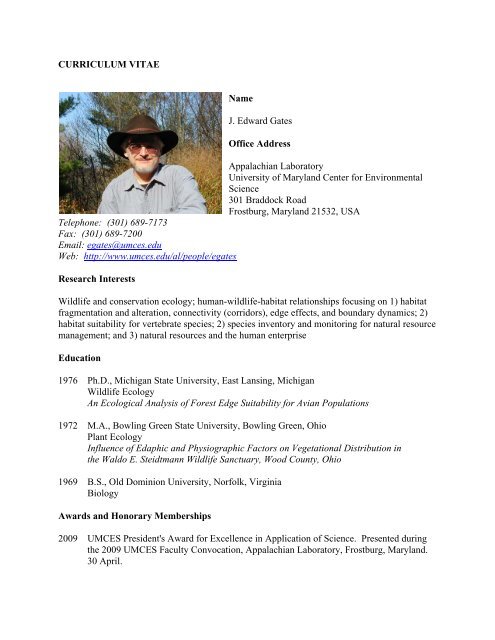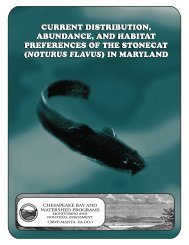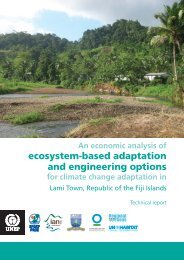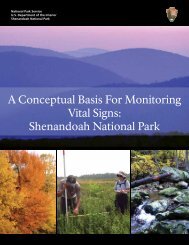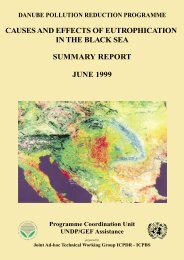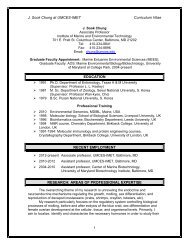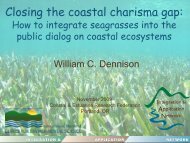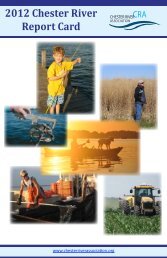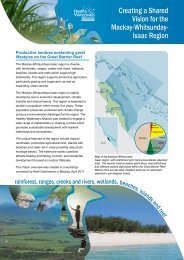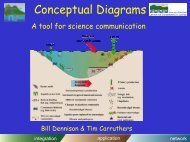Curriculum vitae - The University of Maryland Center for ...
Curriculum vitae - The University of Maryland Center for ...
Curriculum vitae - The University of Maryland Center for ...
You also want an ePaper? Increase the reach of your titles
YUMPU automatically turns print PDFs into web optimized ePapers that Google loves.
CURRICULUM VITAENameJ. Edward GatesOffice AddressAppalachian Laboratory<strong>University</strong> <strong>of</strong> <strong>Maryland</strong> <strong>Center</strong> <strong>for</strong> EnvironmentalScience301 Braddock RoadFrostburg, <strong>Maryland</strong> 21532, USATelephone: (301) 689-7173Fax: (301) 689-7200Email: egates@umces.eduWeb: http://www.umces.edu/al/people/egatesResearch InterestsWildlife and conservation ecology; human-wildlife-habitat relationships focusing on 1) habitatfragmentation and alteration, connectivity (corridors), edge effects, and boundary dynamics; 2)habitat suitability <strong>for</strong> vertebrate species; 2) species inventory and monitoring <strong>for</strong> natural resourcemanagement; and 3) natural resources and the human enterpriseEducation1976 Ph.D., Michigan State <strong>University</strong>, East Lansing, MichiganWildlife EcologyAn Ecological Analysis <strong>of</strong> Forest Edge Suitability <strong>for</strong> Avian Populations1972 M.A., Bowling Green State <strong>University</strong>, Bowling Green, OhioPlant EcologyInfluence <strong>of</strong> Edaphic and Physiographic Factors on Vegetational Distribution inthe Waldo E. Steidtmann Wildlife Sanctuary, Wood County, Ohio1969 B.S., Old Dominion <strong>University</strong>, Norfolk, VirginiaBiologyAwards and Honorary Memberships2009 UMCES President's Award <strong>for</strong> Excellence in Application <strong>of</strong> Science. Presented duringthe 2009 UMCES Faculty Convocation, Appalachian Laboratory, Frostburg, <strong>Maryland</strong>.30 April.
J. Edward Gates <strong>Curriculum</strong> Vitae Page 3 <strong>of</strong> 34<strong>Maryland</strong>1982-2010 Associate Pr<strong>of</strong>essor, Appalachian Laboratory, <strong>University</strong> <strong>of</strong> <strong>Maryland</strong> <strong>Center</strong> <strong>for</strong>Environmental Science, andAdjunct Associate Pr<strong>of</strong>essor, Department <strong>of</strong> Biology, Frostburg State <strong>University</strong>,Frostburg, <strong>Maryland</strong>1977-1982 Assistant Pr<strong>of</strong>essor, Appalachian Environmental Laboratory, <strong>Center</strong> <strong>for</strong>Environmental and Estuarine Studies, <strong>University</strong> <strong>of</strong> <strong>Maryland</strong>, andAdjunct Assistant Pr<strong>of</strong>essor, Department <strong>of</strong> Biology, Frostburg State <strong>University</strong>,Frostburg, <strong>Maryland</strong>Teaching and Graduate Training1979– Regular Member, Marine, Estuarine, and Environmental Sciences (MEES)Graduate Faculty1983–1997 Regular Member, <strong>University</strong> <strong>of</strong> <strong>Maryland</strong> System Graduate Faculty1997– Regular Member, <strong>University</strong> System <strong>of</strong> <strong>Maryland</strong> (USM) Inter-InstitutionalGraduate Faculty1990–2014 Regular Member, <strong>University</strong> <strong>of</strong> <strong>Maryland</strong> <strong>Center</strong> <strong>for</strong> Environmental Science(UMCES) Graduate Faculty (reappointment every 5 years by UMCES President)Courses Taught Wildlife Techniques (3 cr.). Fall 1977. Wildlife Habitat Management and Analysis (3 cr.) (Renamed Wildlife Habitat Ecology andAnalysis in 1995). Taught annually in Fall 1978-1983, and since then in odd-numberedyears. <strong>The</strong> course covers topics in habitat selection, territoriality and habitat suitability,optimal <strong>for</strong>aging and habitat quality, edge effects and habitat suitability, habitatfragmentation, reserve design, corridors and landscape linkages, and landscape ecology.Class enrollment has averaged 10 graduate students, with a high <strong>of</strong> 23. Wildlife Habitat Ecology and Analysis (2-3 cr.). Commencing with fall 1999, this course hasbeen <strong>of</strong>fered <strong>for</strong> 2 credits (without laboratory) via the Interactive Video Network (IVN) tocampuses within the <strong>University</strong> System <strong>of</strong> <strong>Maryland</strong>. <strong>The</strong> FSU course also included fieldlaboratory experience. Wildlife Habitat Ecology and Analysis (3 cr.). Beginning with fall 2003, the course becamestrictly a 3-hour, 3-credit course <strong>of</strong>fered via IVN and at AL. Seminar in Fisheries and Wildlife Management (1 cr.). <strong>The</strong> Seminar in Fisheries andWildlife Management has had as many as 24+ graduate students. It was rotated among thefaculty. I taught it twice. Independent Study in Wildlife (2-3 cr.). Spring 1992. Important Issues in Ecology and Environmental Science (1 cr.). Spring 2000. Topics in Wildlife and Conservation Ecology (1 cr.). This course is available via the
J. Edward Gates <strong>Curriculum</strong> Vitae Page 5 <strong>of</strong> 34Lutmerding, Jo Anna. M.S. Temporal and spatial patterns <strong>of</strong> nocturnal bird migration inthe Appalachian Mountains <strong>of</strong> western <strong>Maryland</strong>. Applied Ecology and ConservationBiology; Frostburg State <strong>University</strong>.2008 Lott, Keith D. M.S. <strong>The</strong>sis title: Daily and seasonal patterns <strong>of</strong> bat activity along CentralAppalachian ridges. Applied Ecology and Conservation Biology, Frostburg State<strong>University</strong>.2007 Fiscus, Dan. Ph.D. Dissertation title: Environmental science <strong>for</strong> long-term solution <strong>of</strong>excess nitrogen loading to surface waters and related chronic and systemic humanenvironmentproblems. Marine, Estuarine, and Environmental Sciences (MEES),Environmental Science AOS, <strong>University</strong> <strong>of</strong> <strong>Maryland</strong> College Park.2005 Schmeling, Barbara K. M.S. <strong>The</strong>sis title: <strong>The</strong> effects <strong>of</strong> burning on marsh birds,Blackwater National Wildlife Refuge, <strong>Maryland</strong>. Applied Ecology and ConservationBiology, Frostburg State <strong>University</strong>.Kalasz, Kevin S. M.S. <strong>The</strong>sis title: Bird community response to local and landscapescale variables at Monocacy National Battlefield in Frederick, <strong>Maryland</strong>. AppliedEcology and Conservation Biology, Frostburg State <strong>University</strong>.2004 Kerns, Jessica J. M.S. <strong>The</strong>sis title: Avian response to landscape rehabilitation at RockyGap Lodge and Golf Resort, Allegany County, <strong>Maryland</strong>. Applied Ecology andConservation Biology, Frostburg State <strong>University</strong>.2003 Eineichner, Blayne E. M.S. <strong>The</strong>sis title: Nest box occupancy and breeding success <strong>of</strong>secondary cavity-nesting birds: effects <strong>of</strong> nest box design and placement in a golf-courselandscape. Applied Ecology and Conservation Biology, Frostburg State <strong>University</strong>.Zuria, Iriana. Ph.D. Dissertation title: Birds and field margins in an agriculturallandscape <strong>of</strong> Guanajuato, Mexico. Marine, Estuarine, and Environmental Sciences(MEES), Ecology AOS, <strong>University</strong> <strong>of</strong> <strong>Maryland</strong> College Park.2002 Peters, Scott E. M.S. <strong>The</strong>sis title: An evaluation <strong>of</strong> track-plate surveys <strong>for</strong> detectingfishers (Martes pennanti) in northwestern Pennsylvania. Wildlife/Fisheries Biology,Frostburg State <strong>University</strong>.1997 Garrett, Richard J. M.S. <strong>The</strong>sis title: Effect <strong>of</strong> edge and canopy cover on breeding birdsalong road corridors in western <strong>Maryland</strong>. Applied Ecology and Conservation Biology,Frostburg State <strong>University</strong>.1995 McLeod, Roderick F. M.S. <strong>The</strong>sis title: <strong>The</strong> effects <strong>of</strong> timber harvest and prescribedburning on the distribution and abundance <strong>of</strong> reptiles and amphibians at RemingtonFarms, <strong>Maryland</strong>. Wildlife Management, Frostburg State <strong>University</strong>.Fregonara, James M. M.S. <strong>The</strong>sis title: Landscape composition and structure in the
J. Edward Gates <strong>Curriculum</strong> Vitae Page 6 <strong>of</strong> 34vicinity <strong>of</strong> Barn Owl (Tyto alba pratincola Bonaparte) nest sites in <strong>Maryland</strong>. WildlifeManagement, Frostburg State <strong>University</strong>.Evans, Daniel R. M.S. <strong>The</strong>sis title: <strong>The</strong> role <strong>of</strong> vegetation and avian density in selection<strong>of</strong> Brown-headed Cowbird breeding areas. Wildlife Management, Frostburg State<strong>University</strong>.Farr, Patricia M. M.S. <strong>The</strong>sis title: Effects <strong>of</strong> interstate highway construction on abreeding bird assemblage. Wildlife Management, Frostburg State <strong>University</strong>.1994 Smith, Scott A.; M.S.; Wildlife Management; August 1994; Frostburg State <strong>University</strong>.“Home range and habitat use <strong>of</strong> ring-necked pheasants (Phasianus colchicus L.) in northcentral<strong>Maryland</strong>.”Stewart, Nancy J.; M.S.; Wildlife Management; August 1994; Frostburg State<strong>University</strong>. “Nest success, productivity, and mortality <strong>of</strong> ring-necked pheasants(Phasianus colchicus L.) in north-central <strong>Maryland</strong>.”1993 Gates, William R.; M.S.; Wildlife Management; December 1993; Frostburg State<strong>University</strong>. “Mammalian use <strong>of</strong> over-sized stream culverts under Interstate 97, AnneArundel County, <strong>Maryland</strong>.”McKearnan, Joan E. Ph.D. Dissertation title: Distribution <strong>of</strong> breeding birds and artificialnest predation in riparian zones <strong>of</strong> the central Appalachians. Marine, Estuarine, andEnvironmental Sciences (MEES), Environmental Science AOS, <strong>University</strong> <strong>of</strong> <strong>Maryland</strong>College Park.1992 Karwowski, Kenneth; M.S.; Wildlife Management; May 1992; Frostburg State<strong>University</strong>. “Breeding biology <strong>of</strong> Common Terns nesting on human-made and naturalislands in the St. Lawrence River, New York.”Kawula, Robert J.; M.S.; Wildlife Management; December 1992; Frostburg State<strong>University</strong>. “Effects <strong>of</strong> interstate highway construction and vehicular use on white-taileddeer and medium-sized mammals.”1991 Durner, George M. M.S. <strong>The</strong>sis title: Home range and habitat use <strong>of</strong> black rat snakes onRemington Farms, <strong>Maryland</strong>. Wildlife Management, Frostburg State <strong>University</strong>.1988 Hibbard, Catherine J. M.S. <strong>The</strong>sis title: Relationship <strong>of</strong> salamander and small mammaldiversity and abundance to log microhabitat characteristics. Wildlife Management,Frostburg State <strong>University</strong>.1985 Hill, Steven R. M.S. <strong>The</strong>sis title: Fledging success <strong>of</strong> the eastern phoebe in relation tonest-site microhabitat. Wildlife Management, Frostburg State <strong>University</strong>.13.Bendel, Peter R. M.S. <strong>The</strong>sis title: Home range, activity, and microhabitat partitioning
J. Edward Gates <strong>Curriculum</strong> Vitae Page 7 <strong>of</strong> 34<strong>of</strong> the southern flying squirrel (Glaucomys volans). Wildlife Management, FrostburgState <strong>University</strong>.1984 Giffen, Neil R. M.S. <strong>The</strong>sis title: Bird population patterns across a riparian zoneeasternhemlock-northern hardwood transition. Wildlife Management, Frostburg State<strong>University</strong>.1983 Lang, Brian K. M.S. <strong>The</strong>sis title: Winter bed-site selection by white-tailed deer in ahemlock-northern hardwood <strong>for</strong>est. Wildlife Management, Frostburg State <strong>University</strong>.McDowell-Griffith, Lizabeth. M.S. <strong>The</strong>sis title: Feeding habits <strong>of</strong> cave-dwelling bats inthe central Appalachians. Wildlife Management, Frostburg State <strong>University</strong>.Davis-Chase, Janis. M.S. <strong>The</strong>sis title: Habitat characteristics, population size, and homerange <strong>of</strong> the bog turtle, Clemmys muhlenbergii, in <strong>Maryland</strong>. Wildlife Management,Frostburg State <strong>University</strong>.Gilmore, Robert M. M.S. <strong>The</strong>sis title: Patterns <strong>of</strong> habitat use by the southern flyingsquirrel in a hemlock-northern hardwood ecotone. Wildlife Management, FrostburgState <strong>University</strong>.1982 Christianson, Carl J. M.S. <strong>The</strong>sis title: Habitat partitioning by small mammalsoccupying stripmines in western <strong>Maryland</strong>. Wildlife Management, Frostburg State<strong>University</strong>.Raesly, Richard L. M.S. <strong>The</strong>sis title: Winter habitat selection by cave-dwelling bats: amultivariate analysis. Wildlife Management, Frostburg State <strong>University</strong>.1981 Morgan, Kevin A. M.S. <strong>The</strong>sis title: Wildlife use <strong>of</strong> strip vegetation at RemingtonFarms, <strong>Maryland</strong>. Wildlife Management, Frostburg State <strong>University</strong>.1980 Ladino, Anthony G. M.S. <strong>The</strong>sis title: Animal activity patterns in transmission-linecorridor and adjacent habitats. Wildlife Management, Frostburg State <strong>University</strong>.Chasko, Gregory G. M.S. <strong>The</strong>sis title: <strong>The</strong> suitability <strong>of</strong> grassland and shrublandhabitats within a transmission-line corridor <strong>for</strong> avian populations. Wildlife Management,Frostburg State <strong>University</strong>.Thompson, Edward L. M.S. <strong>The</strong>sis title: Breeding site ecology <strong>of</strong> Ambystomatidsalamanders in <strong>Maryland</strong>. Wildlife Management, Frostburg State <strong>University</strong>.Eaton, Robert H. M.S. <strong>The</strong>sis title: Habitat use by white-tailed deer at two transmissionline corridor sites managed with different techniques. Wildlife Management, FrostburgState <strong>University</strong>
J. Edward Gates <strong>Curriculum</strong> Vitae Page 8 <strong>of</strong> 34Current Member <strong>of</strong> Graduate CommitteeBrenda V. Curry M.S. Wildlife/Fisheries Biology FSUDana T. Strang M.S. Applied Ecology and Conservation Biology FSUAppointments, Committee Memberships, and ServiceFederal, State, and Local GovernmentMember, <strong>Maryland</strong> Public Service Commission Technical Advisory Group (TAG) onAvian and Bat Issues Associated with Wind-Powered Electricity. 8 March 2005–6 June2006.Wildlife Pr<strong>of</strong>essional Representative, Green Ridge State Forest Advisory Committee,<strong>Maryland</strong> Department <strong>of</strong> Natural Resources. 1991-present.<strong>University</strong> System <strong>of</strong> <strong>Maryland</strong> (USM) Chair, USM Wildlife Science Education Committee. 1999-2004.<strong>University</strong> <strong>of</strong> <strong>Maryland</strong> <strong>Center</strong> <strong>for</strong> Environmental Science (UMCES)I have been a member or chaired many UMCES committees, including— Chair, UMCES Institutional Animal Care and Use Committee (IACUC), appointed byPresident Donald F. Boesch, effective 1 January 2004-present. Member <strong>of</strong> UMCES Institutional Animal Care and Use Committee (IACUC) 1997-2003. CEES Graduate Education Committee. Student Vertebrate Animal Research Committee (SVARC) 1996-2000. Member <strong>of</strong> Search Committee <strong>for</strong> President <strong>of</strong> the <strong>Center</strong> <strong>for</strong> Environmental andEstuarine Studies (CEES). 1989-1990. Member <strong>of</strong> UMCEES (UMCES) Faculty Senate, 1984-1987, 1994-1997 (Secretary <strong>for</strong> 2years), 2008-present.UMCES Appalachian Laboratory (AL)I have directly supervised several AL technicians and research assistants over my career,including Hugh P. McIsaac (Faculty Research Assistant, 1985-1989), Joshua B. Johnson(Faculty Research Assistant, 2003-2008), Stephanie D. Dickey (Faculty Research Assistant,2006-present), and Aimee Haskew (Faculty Research Assistant, 2008-present)Since 1977, I have been a member or chair <strong>of</strong> an assortment <strong>of</strong> committees at AL. A few arelisted below— AL Seminar Coordinator, Fall 2010.
J. Edward Gates <strong>Curriculum</strong> Vitae Page 9 <strong>of</strong> 34 AL Seminar Coordinator, Fall 1999–Spring 2005. I coordinated 7 speakers in fall 1999,9 speakers in spring 2001, 7 speakers in fall 2001, 11 speakers in spring 2002, 9 speakersin fall 2002, 12 speakers in spring 2003, 11 speakers in fall 2003, 7 speakers in fall 2004,and 11 speakers in spring 2005 during our regular seminar series. I also set up twospecial seminars, one on 10 April and another on 16 August 2001. Member, AL Faculty Retreat Committee, and Co-presenter in Session 3, “GraduateEducation: Quality and Quantity,” 1999. Member, AL Alumni Reunion Committee, 1999-2001. Member, AL Graduate Education Committee, 2001-2003.Member, AL Grounds Committee, 1998-present.Member <strong>of</strong> 17 Search Committees, 7 as Chair, <strong>for</strong> faculty positions at the AppalachianLaboratory, <strong>Center</strong> <strong>for</strong> Environmental and Estuarine Studies, <strong>University</strong> <strong>of</strong> <strong>Maryland</strong>System, Frostburg, <strong>Maryland</strong>, 1977, 1979, 1982, 1983, 1984, 1985, 1986, 1987, 1988,1993-1994, 1996-1997, 2002, 2005, 2008.Member and Chair <strong>of</strong> numerous UMCES Promotion and Tenure Committees, as well asoutside reviewer <strong>for</strong> faculty members at Pennsylvania State <strong>University</strong> (1995) and<strong>University</strong> <strong>of</strong> Georgia (2000).Member <strong>of</strong> Search Committee <strong>for</strong> Director <strong>of</strong> the Appalachian EnvironmentalLaboratory, <strong>Center</strong> <strong>for</strong> Environmental and Estuarine Studies, <strong>University</strong> <strong>of</strong> <strong>Maryland</strong>System, Frostburg, <strong>Maryland</strong>, 1995-1996.Chair, Ad Hoc Committee <strong>for</strong> Strategic Faculty Development at the AppalachianEnvironmental Laboratory. Report entitled, “Faculty Recruitment and DevelopmentStrategy <strong>for</strong> the Appalachian Environmental Laboratory: A Landscape and RestorationEcology Research Initiative,” submitted to Dr. Donald F. Boesch, President, UMCEES,1991.Member <strong>of</strong> Task Force <strong>for</strong> the establishment <strong>of</strong> a <strong>Maryland</strong> Cooperative Fishery andWildlife Research Unit at UMCEES-AEL, 1987-1989.Member <strong>of</strong> Search Committee <strong>for</strong> faculty position in plant ecology in the Department <strong>of</strong>Biology, Frostburg State <strong>University</strong>, Frostburg, <strong>Maryland</strong>, 1989. Chair, Computer Committee, Appalachian Environmental Laboratory. 1979-1996.Member, AEL Computer Committee, 1996-2003.Frostburg State <strong>University</strong> (FSU)Member, FSU Institutional Animal Care and Use Committee (IACUC). Appointed byDr. Catherine R. Gira, President, Frostburg State <strong>University</strong>, on 13 December 2001-present.Pr<strong>of</strong>essional SocietiesI have served my pr<strong>of</strong>essional societies in various capacities, including—<strong>The</strong> Wildlife Society Representative on American Wind and Wildlife Institute (AWWI)Scientific Advisory Committee, 2009–presentCo-host <strong>of</strong> Symposium on “Economic Growth and It’s Effect on Wildlife: A
J. Edward Gates <strong>Curriculum</strong> Vitae Page 10 <strong>of</strong> 34Collaborative Symposium Among TWS Working Groups,” <strong>for</strong> <strong>The</strong> Wildlife Society15 th Annual Conference, Miami, Florida, 8–12 November 2008. This symposium washeld on 11 November from 0800-1210. I moderated the second half <strong>of</strong> the symposium,as well as the panel discussion that followed the paper presentations.Organizer (with Brian Czech) <strong>of</strong> Symposium on “Peak Oil, Economic Growth, andWildlife Conservation,” <strong>for</strong> <strong>The</strong> Wildlife Society 13 th Annual Conference, Anchorage,Alaska, 23–27 September 2006. This symposium was held on 26 September from0800-1210. Besides presenting the introductory paper, I moderated the first half <strong>of</strong> thesymposium, and participated in the panel discussion that followed the paperpresentations Associate Editor, Wildlife Society Bulletin. Appointed to a 3-year term, 15 March 2001–15 March 2004. I recommended reviewers to the Editor-in-Chief; corresponded withreviewers, authors, and the Editor-in-Chief and his assistant; reviewed all manuscripts;and either rejected or recommended acceptance <strong>of</strong> each manuscript. Of 47 manuscriptsreviewed, I recommended 16 (34%) <strong>for</strong> publicationTreasurer, Working Group <strong>for</strong> the Steady State Economy, <strong>The</strong> Wildlife Society. Electedto a 2-year term on 9 November 2006. <strong>The</strong> duties <strong>of</strong> the Treasurer include maintainingthe WGs checking account and issuing checksSecretary, Working Group <strong>for</strong> the Steady State Economy, <strong>The</strong> Wildlife Society. Electedto a 2-year term on 9 November 2004. <strong>The</strong> duties <strong>of</strong> the Secretary include recordingand issuing the minutes <strong>of</strong> all meetings, and maintaining the Working Group's files andrecords Co-chair <strong>of</strong> Local Committee hosting an annual meeting (American Society <strong>of</strong>Mammalogists, 9-13 June 1990) Chair Public Statements and Resolutions Committee, <strong>Maryland</strong>-Delaware Chapter <strong>of</strong><strong>The</strong> Wildlife Society 1990-1993 Session Chair at annual meetings (American Ornithologists’ Union, 8-10 August 1989) Board Member at Large <strong>of</strong> the <strong>Maryland</strong>-Delaware Chapter <strong>of</strong> <strong>The</strong> Wildlife Society1987-1989 Advisor to the Frostburg State <strong>University</strong> Student Chapter <strong>of</strong> <strong>The</strong> Wildlife Society 1983-1995AEL Representative to the National Association <strong>of</strong> <strong>University</strong> Fish and Wildlife ProgramAdministrators Meeting (1982-1986)Guest Editor, Northeastern Naturalist. Day-Roosts <strong>of</strong> Myotis leibii in the AppalachianRidge and Valley <strong>of</strong> West Virginia by Joseph S. Johnson, James D. Kiser, Kristen S.Watrous, and Trevor S. Peterson (2010).Reviewer <strong>of</strong> proposals (NSF, <strong>Maryland</strong> DNR, National Geographic Society, Florida Fishand Game) and numerous manuscripts <strong>for</strong> the following pr<strong>of</strong>essional journals anduniversity presses—American Midland Naturalist, 1986, 1989American Naturalist, 1986Auk, 1982, 1984, 1997, 2000Condor, 1993Conservation Biology, 1993, 1998
J. Edward Gates <strong>Curriculum</strong> Vitae Page 11 <strong>of</strong> 34Ecology, 1997, 1999Ecological Applications, 1998Forest Ecology and Management, 1997Great Basin Naturalist, 1997Herpetological Review, 1986, 1993Jack-Pine Warbler, 1979Johns Hopkins <strong>University</strong> Press, 1984Journal <strong>of</strong> Avian Biology, 1995Journal <strong>of</strong> Field Ornithology, 1986, 1991, 1993Journal <strong>of</strong> Mammalogy, 1989, 1992Journal <strong>of</strong> the Elisha Mitchell Scientific Society, 1996, 2000Journal <strong>of</strong> Wildlife Management, 1987, 1988, 1989, 1990, 1995, 1996Landscape Ecology, 1996, 1998, 1999<strong>Maryland</strong> Partners in Flight (PIF), Management Committee, “Land ManagementGuidelines <strong>for</strong> the Preservation <strong>of</strong> Birds in <strong>Maryland</strong>,” 1997National Geographic Society, 1986National Science Foundation, Population Biology and Physiological EcologyProgram, 1981, 1982, and Ecosystem Studies Program, 1986, 1987Natural Areas Journal, 1995Northeastern Naturalist, 1997Transactions <strong>of</strong> the Northeast Section, <strong>The</strong> Wildlife Society, 1990U.S. Forest Service, Northern Research Station, General Technical Report, 2009<strong>University</strong> <strong>of</strong> Minnesota Press, 1994Wildlife Society Bulletin, 1984, 1985, 1990, 1991, 1998Wilson Bulletin, 1991, 1992, 1993, 2000Current Pr<strong>of</strong>essional AffiliationsEcological Society <strong>of</strong> America<strong>Maryland</strong> Ornithological SocietySociety <strong>for</strong> Conservation Biology<strong>The</strong> Wildlife SocietyCommunity OrganizationsI have given numerous talks to different local community organizations, including Allegany CountyBird Club, 1990, 1994, 2004; and the Garden Club <strong>of</strong> Cumberland, 1995, 2000, 2004, 2008.PublicationsSubmittedJohnson, J. B., and J. E. Gates. Observations <strong>of</strong> Indiana myotis roosting and <strong>for</strong>agingbehavior in Carroll County, <strong>Maryland</strong>. <strong>The</strong> <strong>Maryland</strong> Naturalist.Zuria, I., and J. E. Gates. Species richness and abundance <strong>of</strong> birds in field margins <strong>of</strong>
J. Edward Gates <strong>Curriculum</strong> Vitae Page 12 <strong>of</strong> 34In Presscentral Mexico: local and landscape-scale effects. Biodiversity and Conservation.2010 Johnson, J. B., J. E. Gates, and N. P. Zegre. Seasonal bat activity on a coastal barrierisland in <strong>Maryland</strong>, USA. Environmental Monitoring and Assessment.Gates, J. E., and J. B. Johnson. 2010. Bat inventory <strong>of</strong> Assateague Island NationalSeashore. Natural Resource Technical Report NPS/NCBN/NRTR—2010/284. NationalPark Service, Fort Collins, Colorado.Published2010 Lookingbill, T. R., A. J. Elmore, K. A. M. Engelhardt, J. B. Churchill, J. E. Gates, andJ. B. Johnson. Influence <strong>of</strong> wetland networks on bat activity in mixed-use landscapes.Biological Conservation 143(4):974-983.2009 Almario, B. J., P. P. Marra, J. E. Gates, and L. Mitchell. Effects <strong>of</strong> prescribed fire ondepredation rates <strong>of</strong> natural and artificial Seaside Sparrow nests. <strong>The</strong> Wilson Journal <strong>of</strong>Ornithology 121(4):770-777.Johnson, J. B., J. E. Gates, and M. R. Ford. Notes on <strong>for</strong>aging activity <strong>of</strong> female Myotisleibii in <strong>Maryland</strong>. U.S. Department <strong>of</strong> Agriculture, Forest Service, Northern ResearchStation, Newtown Square, Pennsylvania. Research Paper NRS-8. 8 pp.Johnson, J. B., J. W. Edwards, W. M. Ford, and J. E. Gates. Roost tree selection bynorthern myotis (Myotis septentrionalis) maternity colonies following prescribed fire in aCentral Appalachian Mountains hardwood <strong>for</strong>est. Forest Ecology and Management258:233-242.2008 Johnson, J. B., and J. E. Gates. Spring migration and roost selection <strong>of</strong> female Myotisleibii in <strong>Maryland</strong>. Northeastern Naturalist 15(3):453-460.Johnson, J. B., and J. E. Gates. Bats <strong>of</strong> Assateague Island National Seashore, <strong>Maryland</strong>.American Midland Naturalist 160(1):160-170.Johnson, J. B., J. E. Gates, and W. M. Ford. Distribution and activity <strong>of</strong> bats at local andlandscape scales within a rural-urban gradient. Urban Ecosystems 11(2):227-242.Haskew, A. N., and J. E. Gates. 2008. When conservation conflicts with recreation.Bat Research News 49(4):126 (abstract only).2007 Johnson, J. B., and J. E. Gates. Food habits <strong>of</strong> Myotis leibii during fall swarming inWest Virginia. Northeastern Naturalist 14(3):317-322.
J. Edward Gates <strong>Curriculum</strong> Vitae Page 13 <strong>of</strong> 34Gates, J. E. Consensus building and the democratic process: TWS position statements.<strong>The</strong> Wildlife Pr<strong>of</strong>essional 1(3):40.Zuria, I., J. E. Gates, and I. Castellanos. Artificial nest predation in hedgerows and scrub<strong>for</strong>est in a human-dominated landscape <strong>of</strong> central Mexico. Acta Oecologica31(2007):158-167.McCrary, J. K., and J. E. Gates. Evidences <strong>of</strong> brood parasitism <strong>of</strong> Giant Cowbird(Molothrus oryzivorus) on Spot-breasted (Icterus pectoralis) and Streak-backed (I.pustulatus) orioles. Ornitologia Neotropical 18:111-115.Gates, J. E., and J. B. Johnson. Bat inventories <strong>of</strong> four Eastern Rivers and MountainsNetwork National Parks. Technical Report NPS/NER/NRTR—2007/098, National ParkService, Philadephia, Pennsylvania, USA. 142 pp.2006 Gates, J. E. Forest fragmentation. Page 64 in R. Abramson and J. Haskell, editors.Encyclopedia <strong>of</strong> Appalachia. <strong>The</strong> <strong>University</strong> <strong>of</strong> Tennessee Press, Knoxville, Tennessee,USA.Gates, J. E., and J. B. Johnson. Bat-swarming inventory at abandoned mine portals atNew River Gorge National River, West Virginia. Technical Report NPS/NER/NRTR--2006/046. National Park Service, Philadelphia, Pennsylvania, USA. 55 pp.Gates, J. E., N. K. Dawe, J. D. Erickson, J. C. Farley, V. Geist, H. Hands, P. Magee, andD. L. Trauger. Perspectives on <strong>The</strong> Wildlife Society’s economic growth policy statementand the development process. Wildlife Society Bulletin 34(2):507-511.Zuria, I., and J. E. Gates. Vegetated field margins in Mexico: their history, structure andfunction, and management. Human Ecology 34(1): 530-77.2005 Johnson, J. B., and J. E. Gates. Bat emergence and swarming surveys at 4 western<strong>Maryland</strong> caves. <strong>The</strong> <strong>Maryland</strong> Naturalist 47(1):1-13.2003 Gates, J. E., and J. E. McKearnan. Artificial nest predation across riparian-upland <strong>for</strong>estecotones. Southeastern Naturalist 2(2):301-312.1999 Smith, S. A., N. J. Stewart, and J. E. Gates. Home ranges, habitat selection andmortality <strong>of</strong> ring-necked pheasants (Phasianus colchicus) in north-central <strong>Maryland</strong>.American Midland Naturalist 141(1):185-197.Precht, F. L., D. R. Evans, and J. E. Gates. Simulating spatial patterns <strong>of</strong> brown-headedcowbird brood parasitism in the Central Appalachians. Geographical and EnvironmentalModelling 3(2):179-202.1998 Gates, J. E., and D. R. Evans. Cowbirds breeding in the central Appalachians: spatialand temporal patterns and habitat selection. Ecological Applications 8(1):27-40.
J. Edward Gates <strong>Curriculum</strong> Vitae Page 14 <strong>of</strong> 34McLeod, R. F., and J. E. Gates. Response <strong>of</strong> herpet<strong>of</strong>aunal communities to <strong>for</strong>estcutting and burning at Chesapeake Farms, <strong>Maryland</strong>. American Midland Naturalist139(1):164-177.1997 Evans, D. R., and J. E. Gates. Cowbird selection <strong>of</strong> breeding areas: the role <strong>of</strong> habitatand bird species abundance. Wilson Bulletin 109(3):470-480.1996 Kawula, R. J., J. E. Gates, and W. R. Gates. Response <strong>of</strong> deer and medium-sizedmammals to interstate highway construction and operation. Journal <strong>of</strong> the ElishaMitchell Scientific Society 112(1):31-39.1995 Karwowski, K., J. E. Gates, and L. H. Harper. Common terns nesting on navigation aidsand natural islands in the St. Lawrence River, New York. Wilson Bulletin 107(3):423-436.Gates, J. E. Point count modifications and breeding bird abundances in centralAppalachian <strong>for</strong>ests. Pages 135-144 in C. J. Ralph, J. R. Sauer, and S. Droege, technicaleditors. Monitoring bird populations by point counts. U.S.D.A. Forest Service, GeneralTechnical Report PSW-GTR-149.1994 Gates, J. E. Edge effects on avian nest success. Conservation Biology 8(3):618-620.1993 Durner, G. M., and J. E. Gates. Spatial ecology <strong>of</strong> black rat snakes on RemingtonFarms, <strong>Maryland</strong>. Journal <strong>of</strong> Wildlife Management 57(4):812-826.Gates, J. E. Highways: the search <strong>for</strong> solutions. Pages 46-52 in R. L. Donald, editor.Deer management in an urbanizing region: problems and alternatives to traditionalmanagement. Proceedings <strong>of</strong> the Conference, held April 13, 1988, <strong>The</strong> NationalConference <strong>Center</strong>, East Windsor, New Jersey. Updated in 1993. Humane Society <strong>of</strong> theUnited States, Washington, D.C., USA.1991 Gates, J. E., and N. R. Giffen. Neotropical migrant birds and edge effects at a<strong>for</strong>est-stream ecotone. Wilson Bulletin 103(2):204-217.Gates, J. E. Powerline corridors, edge effects, and wildlife in <strong>for</strong>ested landscapes <strong>of</strong> thecentral Appalachians. Pages 13-32 in J. E. Rodiek and E. G. Bolen, eds. Wildlife andhabitats in managed landscapes. Island Press, Washington, D. C., USA1989 Chase, J. D., K. R. Dixon, J. E. Gates, D. Jacobs, and G. J. Taylor. Habitatcharacteristics, population size and home range <strong>of</strong> the bog turtle, Clemmys muhlenbergii,in <strong>Maryland</strong>. Journal <strong>of</strong> Herpetology 23(4):356-362.1988 Hill, S. R., and J. E. Gates. Nesting ecology and microhabitat <strong>of</strong> the eastern phoebe inthe central Appalachians. American Midland Naturalist 120(2):313-324.
J. Edward Gates <strong>Curriculum</strong> Vitae Page 15 <strong>of</strong> 341987 Bendel, P. R., and J. E. Gates. Home range and microhabitat partitioning <strong>of</strong> the southernflying squirrel (Glaucomys volans). Journal <strong>of</strong> Mammalogy 68(2):243-255.Raesly, R. L., and J. E. Gates. Winter habitat selection by north temperate cave bats.American Midland Naturalist 118(1):15-31.1986 Feldhamer, G. A., J. E. Gates, D. M. Harman, A. J. Loranger, and K. R. Dixon. Effects<strong>of</strong> interstate highway fencing on white-tailed deer activity. Journal <strong>of</strong> WildlifeManagement 50(3):497-503.1985 Gates, J. E., R. H. Stouffer, Jr., J. R. Stauffer, Jr., and C. H. Hocutt. Dispersal patterns<strong>of</strong> translocated Cryptobranchus alleganiensis in a <strong>Maryland</strong> stream. Journal <strong>of</strong>Herpetology 19(3):436-438.Gilmore, R. M., and J. E. Gates. Habitat use by the southern flying squirrel at ahemlock-northern hardwood ecotone. Journal <strong>of</strong> Wildlife Management 49(3):703-710.Griffith, L. A., and J. E. Gates. Food habits <strong>of</strong> cave-dwelling bats in the centralAppalachians. Journal <strong>of</strong> Mammalogy 66(3):451-460.Lang, B. K., and J. E. Gates. Selection <strong>of</strong> sites <strong>for</strong> winter night beds by white-tailed deerin a hemlock-northern hardwood <strong>for</strong>est. American Midland Naturalist 113(2):245-254.Gates, J. E., C. H. Hocutt, J. R. Stauffer, Jr., and G. J. Taylor. <strong>The</strong> distribution andstatus <strong>of</strong> Crytobranchus alleganiensis in <strong>Maryland</strong>. Herpetological Review 16(1):17-18.1984 Gates, J. E., G. A. Feldhamer, L. A. Griffith, and R. L. Raesly. Status <strong>of</strong> cave-dwellingbats in <strong>Maryland</strong>: importance <strong>of</strong> marginal habitats. Wildlife Society Bulletin12(2):162-169.Feldhamer, G. A., J. E. Gates, and J. A. Chapman. Rare, threatened, endangered, andextirpated mammals from <strong>Maryland</strong>. Pages 395-438 in A. W. Norden, D. C. Forester,and G. H. Fenwick, editors. Threatened and Endangered Plants and Animals <strong>of</strong><strong>Maryland</strong>. Proceedings <strong>of</strong> a Symposium held September 3-4, 1981, at Towson State<strong>University</strong>, Towson, <strong>Maryland</strong>. Natural Heritage Program Special Publication 84-I.Gates, J. E., C. H. Hocutt, and J. R. Stauffer, Jr. <strong>The</strong> status <strong>of</strong> the hellbender(Cryptobranchus alleganiensis) in <strong>Maryland</strong>. Pages 329-335 in A. W. Norden, D. C.Forester, and G. H. Fenwick, editors. Threatened and Endangered Plants and Animals <strong>of</strong><strong>Maryland</strong>. Proceedings <strong>of</strong> a Symposium held September 3-4, 1981, at Towson State<strong>University</strong>, Towson, <strong>Maryland</strong>. <strong>Maryland</strong> Natural Heritage Program Special Publication84-I.Raesly, R. L., and J. E. Gates. Hibernacula selection by cave-dwelling bats: a test <strong>of</strong> themodels. Transactions <strong>of</strong> the Northeast Fish and Wildlife Conference 41:59-67.
J. Edward Gates <strong>Curriculum</strong> Vitae Page 16 <strong>of</strong> 341983 Feldhamer, G. A., J. E. Gates, and J. H. Howard. Field identification <strong>of</strong> Peromyscusmaniculatus and P. leucopus: reliability <strong>of</strong> morphological characteristics. Acta<strong>The</strong>riologica 28, 27:417-423.Morgan, K. A., and J. E. Gates. Use <strong>of</strong> <strong>for</strong>est edge and strip vegetation by easterncottontails. Journal <strong>of</strong> Wildlife Management 47(1):259-264.Stauffer, J. R., Jr., J. E. Gates, and W. L. Goodfellow. 1983. Preferred temperature <strong>of</strong>two sympatric Ambystoma larvae: a proximate factor in niche segregation? Copeia1983(4):1001-1005.Willner, G. R., J. E. Gates, and W. J. Devlin. Nest box use by cavity nesting birds.American Midland Naturalist 109(1):194-201.Stouffer, R. H., Jr., J. E. Gates, C. H. Hocutt, and J. R. Stauffer, Jr. Surgicalimplantation <strong>of</strong> a transmitter package <strong>for</strong> radio-tracking endangered hellbenders.Wildlife Society Bulletin 11(4):384-386.1982 Chasko, G. G., and J. E. Gates. Avian habitat suitability along a transmission-linecorridor in an oak-hickory <strong>for</strong>est region. Wildlife Monographs 82:1-41.Gates, J. E., and E. L. Thompson. Small pool habitat selection by red-spotted newts inwestern <strong>Maryland</strong>. Journal <strong>of</strong> Herpetology 16(1):7-15.Morgan, K. A., and J. E. Gates. Bird population patterns in <strong>for</strong>est edge and stripvegetation at Remington Farms, <strong>Maryland</strong>. Journal <strong>of</strong> Wildlife Management46(4):933-944.Thompson, E. L., and J. E. Gates. Breeding pool segregation by the mole salamanders,Ambystoma jeffersonianum and A. maculatum, in a region <strong>of</strong> sympatry. Oikos38(3):273-279.Flyger, V., and J. E. Gates. Fox squirrel, gray squirrel, and allies (Sciurus spp.). Pages209-229 in J. A. Chapman and G. A. Feldhamer, eds. Wild Mammals <strong>of</strong> North America:Biology, Management, and Economics. Johns Hopkins <strong>University</strong> Press, Baltimore,<strong>Maryland</strong>, USA.Flyger, V., and J. E. Gates. Pine squirrels (Tamiasciurus hudsonicus and T. douglasii).Pages 230-238 in J. A. Chapman and G. A. Feldhamer, eds. Wild Mammals <strong>of</strong> NorthAmerica: Biology, Management, and Economics. Johns Hopkins <strong>University</strong> Press,Baltimore, <strong>Maryland</strong>, USA.1981 Gates, J. E., and J. A. Mosher. A functional approach to estimating habitat edge width<strong>for</strong> birds. American Midland Naturalist 105(1):189-192.Gates, J. E., and E. L. Thompson. Breeding habitat association <strong>of</strong> spotted salamanders
J. Edward Gates <strong>Curriculum</strong> Vitae Page 17 <strong>of</strong> 34(Ambystoma maculatum) in western <strong>Maryland</strong>. Journal <strong>of</strong> the Elisha Mitchell ScientificSociety 97(3):209-216.Williams, R. D., J. E. Gates, C. H. Hocutt, and G. J. Taylor. <strong>The</strong> hellbender: a nongamespecies in need <strong>of</strong> management. Wildlife Society Bulletin 9(2):94-100.Williams, R. D., J. E. Gates, and C. H. Hocutt. An evaluation <strong>of</strong> known and potentialsampling techniques <strong>for</strong> the hellbender, Cryptobranchus alleganiensis. Journal <strong>of</strong>Herpetology 15(1):23-27.Ladino, A. G., and J. E. Gates. Responses <strong>of</strong> animals to transmission line corridormanagement practices. Pages 53-1–53-10 in R. Tillman, editor. Proceedings <strong>of</strong> theSecond National Symposium on Environmental Concerns in Rights-<strong>of</strong>-WayManagement, 16-18 October 1979, Ann Arbor Michigan. EPRI WS-78-141.Eaton, R. H., and J. E. Gates. Transmission-line rights-<strong>of</strong>-way management and whitetaileddeer habitat: a review. Pages 58-1–58-7 in R. Tillman, editor. Proceedings <strong>of</strong> theSecond National Symposium on Environmental Concerns in Rights-<strong>of</strong>-WayManagement, 16-18 October 1979, Ann Arbor Michigan. EPRI WS-78-141..Gates, J. E., and K. R. Dixon. Right-<strong>of</strong>-way utilization by <strong>for</strong>est- and corridor-breedingbird populations. Pages 66-1–66-7 in R. Tillman, editor. Proceedings <strong>of</strong> the SecondNational Symposium on Environmental Concerns in Rights-<strong>of</strong>-Way Management, 16-18October 1979, Ann Arbor Michigan. EPRI WS-78-141.Lawson, B. A., and J. E. Gates. Habitat-niche discrimination <strong>of</strong> passerines along atransmission-line corridor. Pages 67-1–67-7 in R. Tillman, editor. Proceedings <strong>of</strong> theSecond National Symposium on Environmental Concerns in Rights-<strong>of</strong>-WayManagement, 16-18 October 1979, Ann Arbor Michigan. EPRI WS-78-141.Chasko, G. G. and J. E. Gates. Avian breeding success in relation to grassland andshrubland habitats within a 138 kV transmission-line corridor. Pages 68-1–68-12 in R.Tillman, editor. Proceedings <strong>of</strong> the Second National Symposium on EnvironmentalConcerns in Rights-<strong>of</strong>-Way Management, 16-18 October 1979, Ann Arbor Michigan.EPRI WS-78-141.1980 Gates, J. E., and D. M. Harman. White-tailed deer wintering area in a hemlock-northernhardwood <strong>for</strong>est. Canadian Field-Naturalist 94(3):259-268.Thompson, E. L., J. E. Gates, and G. J. Taylor. Distribution and breeding habitatselection <strong>of</strong> the Jefferson salamander, Ambystoma jeffersonianum, in <strong>Maryland</strong>. Journal<strong>of</strong> Herpetology 14(2):113-120.Gates, J. E., and D. M. Gates. A winter food cache <strong>of</strong> Microtus pennsylvanicus.American Midland Naturalist 103(2):407-408.Chasko, G. G., and J. E. Gates. An apparent instance <strong>of</strong> polygyny in Indigo Buntings
J. Edward Gates <strong>Curriculum</strong> Vitae Page 18 <strong>of</strong> 34from <strong>Maryland</strong>. Proceedings <strong>of</strong> the Pennsylvania Academy <strong>of</strong> Science 54(1):89-90.Feldhamer, G. A., and J. E. Gates. A black rat population in western <strong>Maryland</strong>.Proceedings <strong>of</strong> the Pennsylvania Academy <strong>of</strong> Science 54(2):191-192.1979 Gates, J. E. Avian nest placement in relation to plant height. Jack-Pine Warbler57(4):191-198.Thompson, E. L., and J. E. Gates. Geographic distribution: Ambystomajeffersonianum. Herpetological Review 10(3):101.1978 Gates, J. E., and L. W. Gysel. Avian nest dispersion and fledging success in field-<strong>for</strong>estecotones. Ecology 59(5):871-883.1975 Gates, J. E., and D. M. Gates. Fox squirrel use <strong>of</strong> cocklebur seeds. Journal <strong>of</strong>Mammalogy 56(1):239-240.Gates, D. M., and J. E. Gates. <strong>The</strong> Zoo’s free-living native wildlife. Your Detroit Zoo29(2):6-9.Gates, J. E., and D. M. Gates. Apparent brooding behavior <strong>of</strong> a male Rufous-sidedTowhee. Bird-Banding 46(3):253.Gates, J. E., and D. M. Gates. Nesting Indigo Buntings displaced by Peromyscus.Wilson Bulletin 87(3):421-422.(Note: I maintain a policy <strong>of</strong> only co-authoring with my students on papers to which I havemade a major contribution in study design, data analysis, and writing.)Seminars, Invited Papers, and Papers/Posters Presented at MeetingsOver my career, I have attended 100s <strong>of</strong> pr<strong>of</strong>essional meetings; the following are those at whichmy students or colleagues and I were presenters <strong>of</strong> papers—2010 J. E. Gates, and J. L. Sparks, Jr. Wildlife use <strong>of</strong> existing road drainage structures in<strong>Maryland</strong>. Workshop: Roads and Wildlife in <strong>Maryland</strong>: Assessing and MitigatingImpacts, <strong>Maryland</strong> Department <strong>of</strong> Transportation Headquarters, Hughes ConferenceRoom, Hanover, <strong>Maryland</strong>. 16 March.J. L. Sparks, Jr., and J. E. Gates. Preliminary results <strong>of</strong> an investigation into the use <strong>of</strong>road drainage structures by wildlife in <strong>Maryland</strong>. Workshop: Roads and Wildlife in<strong>Maryland</strong>: Assessing and Mitigating Impacts, <strong>Maryland</strong> Department <strong>of</strong> TransportationHeadquarters, Hughes Conference Room, Hanover, <strong>Maryland</strong>. 16 March.Garabedian, J., F. K. Ammer, and J. E. Gates. Habitat associations <strong>of</strong> over-winteringbirds in restored grasslands in the Manassas National Battlefield Park, Virginia. 87 th
J. Edward Gates <strong>Curriculum</strong> Vitae Page 19 <strong>of</strong> 34Annual Meeting <strong>of</strong> the Eastern Bird Banding Association, Rocky Gap Resort, RockyGap State Park, Flintstone, <strong>Maryland</strong>. 9-11 April.Dickey, S., J. E. Gates, B. Dickey, and K. Ferebee. Bird and bat mortality at short,monopole cell towers, Rock Creek Park, Washington, D.C. Spotlight on National ParkResources in the National Capital Region, Frederick Community College, Frederick,<strong>Maryland</strong>. 20 April.Sjollema, A. L., and J. E. Gates. Bat activity and patterns in the vicinity <strong>of</strong> proposedwind facilities along the mid-Atlantic Coast. 66th Annual Northeast Fish and WildlifeConference, Marriott Boston Newton, Newton, Massachusetts. 25-27 April.2009 Garabedian, J., F. K. Ammer, and J. E. Gates. Habitat preferences <strong>of</strong> over-winteringbirds using restored grasslands in the Manassas National Battlefield Park. SpringMeeting <strong>of</strong> the <strong>Maryland</strong>-Delaware Chapter <strong>of</strong> <strong>The</strong> Wildlife Society, Woodmont Lodgeat the Woodmont Natural Resource Management Area, <strong>Maryland</strong> Department <strong>of</strong> NaturalResources, c/o Fort Frederick State Park, Hancock, <strong>Maryland</strong>. 24 April.Donaldson, E. F., A. Haskew, M. Frieman, and J. E. Gates. Metagenomic analysis <strong>of</strong>the virome <strong>of</strong> eastern North American bats. Bats and Emerging Viral DiseasesWorkshop, National Institute <strong>of</strong> Allergy and Infectious Diseases, National Institutes <strong>of</strong>Health, Legacy Hotel and Meeting Centre, Rockville, <strong>Maryland</strong>. 10-11 September.Garabedian, J., F. K. Ammer, and J. E. Gates. Habitat preferences <strong>of</strong> over-winteringbirds using restored grasslands in the Mannassas National Battlefield Park. Fall Meeting<strong>of</strong> the <strong>Maryland</strong>-Delaware Chapter <strong>of</strong> <strong>The</strong> Wildlife Society, U.S. Fish and WildlifeService, National Wildlife Visitors <strong>Center</strong>, Laurel, <strong>Maryland</strong>. 30 October.Sjollema, A. L., and J. E. Gates. 2009. Bat activity and patterns in the vicinity <strong>of</strong>proposed wind facilities along the Mid-Atlantic coast. 39 th North American Symposiumon Bat Research, Portland, Oregon. 4-7 November.2008 Johnson, J. B., J. E. Gates, and W. M. Ford. Distribution and activity <strong>of</strong> bats at local andlandscape scales within a rural-urban gradient. 1st joint meeting <strong>of</strong> the Northeastern BatWorking Group (NEBWG) and Southeastern Bat Diversity Network (SBDN) and 18thAnnual Colloquium on the Conservation <strong>of</strong> Mammals in the Southeastern United States,Blacksburg,Virginia. 20-22 February.Johnson, J. B., and J. E. Gates. Bat communities at abandoned railroad tunnels inChesapeake and Ohio Canal National Historical Park. National Park Service conference,“Spotlight on National Park Resources.” U.S. Department <strong>of</strong> the Interior, MainAuditorium, Washington, D.C. 26 March.Gates, J. E. Life under a windplant. Introduction, DVD showing, and discussion. <strong>The</strong>Garden Club <strong>of</strong> Cumberland, <strong>Center</strong> Street Methodist Church, Monthly Meeting,Cumberland, <strong>Maryland</strong>. 14 April.
J. Edward Gates <strong>Curriculum</strong> Vitae Page 20 <strong>of</strong> 34Johnson, J. B., and J. E. Gates. Nightly and seasonal bat activity on Assateague IslandNational Seashore, <strong>Maryland</strong>, and implications <strong>for</strong> wind energy development. AWEAOffshore Wind Power Workshop, Wilmington, Delaware. 9-10 September.Haskew, A., and J. E. Gates. When conservation conflicts with recreation: a case study<strong>of</strong> Myotis leibii in western <strong>Maryland</strong>. 38 th North American Symposium on Bat Research,Scranton, Pennsylvania. 22-25 October.Dickey, S. D., J. E. Gates, and B. F. Dickey. <strong>The</strong> effect <strong>of</strong> cell towers on birds and batsat Rock Creek Park, Washington, D.C. <strong>The</strong> Wildlife Society 15 th Annual Conference,Miami, Florida, 8-12 November. Poster presentation, 12 November.Trauger, D. L., and J. E. Gates. Peak oil: implications <strong>for</strong> sustainable natural resourcesmanagement. Sustainable Operations Summit, “Walking the Talk: Reducing ourEnvironmental Footprint.” U.S.D.A. Forest Service, Forest Products Laboratory,Madison, Wisconsin. 17-21 November.2007 Gates, J. E. <strong>The</strong> relationship between economic growth and wildlife conservation.<strong>Maryland</strong>-Delaware Chapter <strong>of</strong> <strong>The</strong> Wildlife Society, Spring Meeting, Greenbrier StatePark, Boonsboro, <strong>Maryland</strong>. 13 April.2006 Lott, K., and J. E. Gates. Daily and seasonal patterns <strong>of</strong> bat activity along CentralAppalachian ridges. Northeast Bat Working Group, 2006 Annual Meeting, EastStroudsburg <strong>University</strong>, East Stroudsburg, Pennsylvania. 10-12 January.Gates, J. E. <strong>The</strong> fundamental conflict between economic gtrowth and wildlifeconservation. Department <strong>of</strong> Biology and Society <strong>for</strong> Conservation Biology StudentChapter, Frostburg State <strong>University</strong>, Frostburg, <strong>Maryland</strong>. 8 March.Gates, J. E., and M. Christian. Peaking <strong>of</strong> world oil extraction. <strong>The</strong> Wildlife Society13 th Annual Conference, Anchorage, Alaska, 23–27 September. Paper presented duringSymposium on “Peak Oil, Economic Growth, and Wildlife Conservation,” 26 September.Trauger, D. L., and J. E. Gates. Implications <strong>of</strong> peak oil <strong>for</strong> wildlife conservation andmanagement. <strong>The</strong> Wildlife Society 13 th Annual Conference, Anchorage, Alaska, 23–27September. Paper presented during Symposium on “Peak Oil, Economic Growth, andWildlife Conservation,” 26 September.Leachman, J. A., and J. E. Gates. A study <strong>of</strong> nocturnal bird migration in theAppalachian Mountains <strong>of</strong> western <strong>Maryland</strong>. 4th North American OrnithologicalConference, Wings without Borders, Veracruz, Mexico, 3-7 October.Haskew, A. N., and J. E. Gates. Pre-closure surveys <strong>of</strong> 52 abandoned coal mines inwestern <strong>Maryland</strong>. 36th Annual North American Symposium on Bat Research, HiltonWilmington Riverside, Wilmington, North Carolina. 18-21 October.
J. Edward Gates <strong>Curriculum</strong> Vitae Page 21 <strong>of</strong> 34Lott, K., and J. E. Gates. Daily and seasonal patterns <strong>of</strong> bat activity along CentralAppalachian ridges. 36th Annual North American Symposium on Bat Research, HiltonWilmington Riverside, Wilmington, North Carolina. 18-21 October.Lott, K., and J. E. Gates. Daily and seasonal patterns <strong>of</strong> bat activity along CentralAppalachian ridges. National Wind Coordinating Collaborative, Wildlife WorkgroupResearch Meeting VI, Radisson Hotel - San Antonio Downtown Market Square,San Antonio, Texas. 14-16 November.2005 Zuria, I., J. E. Gates, and I. Castellanos. Species richness and abundance <strong>of</strong> birds infield margins <strong>of</strong> central Mexico: Local and landscape-scale effects. Ecological Society<strong>of</strong> America, 90th Annual Meeting, Montréal, Canada. 7-12 August.Johnson, J. B., and J. E. Gates. Bats <strong>of</strong> Washington, D.C. Northeast Bat WorkingGroup Meeting, Berkeley Springs Inn, Berkeley Springs, West Virginia. 4–6 January.Gates, J. E., and J. B. Johnson. Bat inventories <strong>of</strong> the National Capital Region NationalParks. People, Places, and Parks: Preservation <strong>for</strong> Future Generations,<strong>The</strong> GeorgeWright Society Biennial Conference on Parks, Protected Areas, and Cultural Sites,Loews Phildelphia Hotel, Philadelphia, Pennsylvania, 14–18 March.Gates, J. E., N. K. Dawe, J. D. Erickson, J. Farley, V. Geist, H. Hands, P. Magee, and D.L. Trauger. A critique <strong>of</strong> TWS position statement on economic growth. <strong>The</strong> WildlifeSociety 12 th Annual Conference, Madison, Wisconsin, 25–29 September.2004 Carpenter, C. P., T. L. Serfass, W. M. Tzilkowski, J. E. Gates, and S. E. Peters. 2004.Habitat characteristics at spraint sites used by river otters along Tionesta Creek innorthwestern Pennsylvania. IXth International Otter Colloquium–Otters: Ambassadors<strong>for</strong> Aquatic Conservation, Frostburg State <strong>University</strong>, Frostburg, <strong>Maryland</strong>. 4–10 June.Gates, J. E. 2004. <strong>The</strong> Effects <strong>of</strong> wind turbines on birds and bats. <strong>The</strong> Garden Club <strong>of</strong>Cumberland, <strong>Center</strong> Street Methodist Church, Monthly Meeting, Cumberland, <strong>Maryland</strong>.11 October.Gates, J. E. 2004. Birds, bats, and wind turbines. <strong>The</strong> Allegany County Bird Club, <strong>The</strong>Allegany County Chapter <strong>of</strong> the <strong>Maryland</strong> Ornithological Society, Monthly Meeting,Frostburg Public Library, Frostburg, <strong>Maryland</strong>. 12 October.2001 Gates, J. E., S. Walters, and D. K. Ingram. Breeding bird response to landscape patternsalong the C & O Canal National Historical Park, USA. Ecological Society <strong>of</strong> America,86th Annual Meeting, Madison, Wisconsin. 5-10 August.Zuria, I., and J. E. Gates. Birds and hedgerows at two spatial scales in an agriculturallandscape <strong>of</strong> Guanajuato, Mexico. Ecological Society <strong>of</strong> America, 86th Annual Meeting,Madison, Wisconsin. 5-10 August.1999 Gates, J. E., and D. K. Ingram. Breeding bird-habitat relationships along the C & OCanal National Historical Park. 117 th Stated Meeting <strong>of</strong> the American Ornithologists’
J. Edward Gates <strong>Curriculum</strong> Vitae Page 22 <strong>of</strong> 34Union, Cornell <strong>University</strong>, Ithaca, New York. 10-14 August.Gates, J. E. Effects <strong>of</strong> physiography and local differences in land use/land cover onbreeding birds <strong>of</strong> the C & O Canal National Historical Park. CBL Seminar Series.Chesapeake Biological Laboratory, Solomons, <strong>Maryland</strong>. 23 April.Gates, J. E. Bird Populations <strong>of</strong> the C & O Canal: treasure trove on the towpath.Seminar. Talbot Chapter <strong>of</strong> the <strong>Maryland</strong> Ornithological Society, Easton, <strong>Maryland</strong>. 15April.Gates, J. E. Cowbird movements and habitat use in the central Appalachians. Seminar.Inter-College Graduate Degree Program in Ecology, Pennsylvania State <strong>University</strong>, StateCollege, Pennsylvania. 1 April.1998 Gates, J. E. Cowbird movements and habitat use on an anthropogenic <strong>for</strong>est landscapein the central Appalachians. Partners-in-Flight, West Virginia Working Group, SpringMeeting, Elkins, West Virginia.1997 Gates, J. E. Effects <strong>of</strong> open corridors in <strong>for</strong>ested landscapes: do the negatives outweighthe positives? Session 37: Symposium. Corridors: are they effective in conservingbiodiversity. 4 th Annual Conference, <strong>The</strong> Wildlife Society, Snowmass, Colorado.Gates, J. E. Open corridors in <strong>for</strong>ested landscapes: local and landscape-level effects onwildlife. Frostburg State <strong>University</strong> Bio-lunch Presentation, 9 October.1996 Gates, J. E., and D. R. Evans. Cowbird spatial ecology on an anthropogenic <strong>for</strong>estlandscape. Ecological Society <strong>of</strong> American 1996 Annual Combined Meeting:Ecologists/Biologists as Problem Solvers, Providence, Rhode Island.Evans, D. R., and J. E. Gates. <strong>The</strong> role <strong>of</strong> habitat and bird abundance in selection <strong>of</strong>brown-headed cowbird breeding areas. Ecological Society <strong>of</strong> American 1996 AnnualCombined Meeting: Ecologists/Biologists as Problem Solvers, Providence, Rhode Island.Gates, J. E. Spatial ecology <strong>of</strong> the brown-headed cowbird. Wildlife andFisheries Seminar Series, West Virginia <strong>University</strong>, Morgantown, West Virginia.Gates, J. E. Ecology <strong>of</strong> brown-headed cowbirds in western <strong>Maryland</strong>. Annual<strong>Maryland</strong> Partners in Flight Meeting, National Wildlife Visitor <strong>Center</strong>, Laurel, <strong>Maryland</strong>.Gates, J. E. Habitat fragmentation and cowbird ecology. Western <strong>Maryland</strong> Group <strong>of</strong>the Sierra Club/FSU Chapter <strong>of</strong> the Wildlife Society Invited Seminar, Frostburg State<strong>University</strong>, Frostburg, <strong>Maryland</strong>.1995 Gates, J. E. <strong>The</strong> role <strong>of</strong> cowbird parasitism in <strong>Maryland</strong> landscapes. CBRM(Chesapeake Bay Research and Monitoring Division) Noon Seminar Series, Department<strong>of</strong> Natural Resources, Annapolis, <strong>Maryland</strong>. 15 February.
J. Edward Gates <strong>Curriculum</strong> Vitae Page 23 <strong>of</strong> 34Evans, D. R., and J. E. Gates. Spatial distribution <strong>of</strong> female Brown-headed Cowbirds inrelation to an anthropogenic <strong>for</strong>est landscape. 51st Annual Northeast Fish and WildlifeConference, Ocean City, <strong>Maryland</strong>. Poster. 9-12 April.Fregonara, J., and J. E. Gates. Landscape composition and structure in the vicinity <strong>of</strong>barn owl nest sites in <strong>Maryland</strong>. 51st Annual Northeast Fish and Wildlife Conference,Ocean City, <strong>Maryland</strong>. 9-12 April.McLeod, R. F., and J. E. Gates. <strong>The</strong> effects <strong>of</strong> timber harvest and prescribed burning onthe distribution and abundance <strong>of</strong> herpet<strong>of</strong>auna. 51st Annual Northeast Fish and WildlifeConference, Ocean City, <strong>Maryland</strong>. 9-12 April.Gates, J. E., and D. R. Evans. Cowbird spatial ecology on anthropogenic <strong>for</strong>estlandscapes. Joint Meeting <strong>of</strong> the Wilson Ornithological Society and <strong>The</strong> VirginiaSociety <strong>of</strong> Ornithology, Williamsburg, Virginia. 4-7 May.Gates, J. E., and D. R. Evans. Cowbird spatial ecology and anthropogenic <strong>for</strong>estlandscapes. <strong>Maryland</strong> Ornithological Society 1995 Conference, Mount Saint Mary’sCollege, Emmitsburg, <strong>Maryland</strong>. 23-25 June.Gates, J. E. Breeding bird species assemblages and <strong>for</strong>est patch size. 80th AnnualEcological Society <strong>of</strong> America Meeting: <strong>The</strong> Transdisciplinary Nature <strong>of</strong> Ecology,Snowbird, Utah. 30 July-3 August.1993 Gates, J. E. Neotropical migratory birds, cowbirds, and altered <strong>for</strong>est landscapes.<strong>Maryland</strong> Ornithological Society Conference, Frostburg State <strong>University</strong>, Frostburg,<strong>Maryland</strong>. 5 June.Gates, J. E. Neotropical migratory birds, cowbirds, and managed <strong>for</strong>est landscapes. 7thAnnual Meeting, Society <strong>for</strong> Conservation Biology, Arizona State <strong>University</strong>, Tempe,Arizona. 9-13 June.Gates, J. E. Neotropical migratory birds, cowbirds, and human-dominated <strong>for</strong>estlandscapes. <strong>The</strong> <strong>University</strong> <strong>of</strong> <strong>Maryland</strong> System, <strong>Center</strong> <strong>for</strong> Environmental and EstuarineStudies, Graduate Student Colloquium, Frostburg State <strong>University</strong>, Frostburg, <strong>Maryland</strong>.25 September.Gates, J. E. Brown-headed cowbirds and human-dominated landscapes. NorthAmerican Research, Workshop on the Ecology and Management <strong>of</strong> Cowbirds, Austin,Texas. 4-5 November.1992 Gates, J. E. 1992. Birds, vegetation zonation, and edge effects in a small Appalachianwatershed. Alumni Seminar Series, Department <strong>of</strong> Biological Sciences, Old Dominion<strong>University</strong>, Norfolk, Virginia. 30 January.
J. Edward Gates <strong>Curriculum</strong> Vitae Page 24 <strong>of</strong> 34Gates, J. E. Patterns <strong>of</strong> breeding bird assemblages on altered <strong>for</strong>est landscapes in theCentral Appalachians. First Joint Meeting, Seventy-third Annual Meeting <strong>of</strong> the WilsonOrnithological Society and Thirty-eighth Meeting <strong>of</strong> the Florida Ornithological Society,Hilton Inn Gateway, Kissimmee, Florida. 9-12 April.1991 Durner, G. M., and J. E. Gates. Home range and habitat use <strong>of</strong> black rat snakes onRemington Farms, MD. 1991 Joint Annual Meeting, <strong>The</strong> 34th Annual Meeting <strong>of</strong> <strong>The</strong>Society <strong>for</strong> the Study <strong>of</strong> Amphibians and Reptiles (SSAR) and <strong>The</strong> 39th Annual Meeting<strong>of</strong> <strong>The</strong> Herpetologists' League, <strong>University</strong> Park, Pennsylvania. 6-11 August.Gates, J. E. Point count modifications and breeding bird abundances in centralAppalachian <strong>for</strong>ests. Workshop on Monitoring Bird Population Trends by Point Counts,U.S. Fish and Wildlife Service and U.S. Forest Service, Beltsville, <strong>Maryland</strong>. 6-7November.1989 Stewart, N. J., S. A. Smith, and J. E. Gates. 1989. Seasonal movements, habitat use,mortality and productivity <strong>of</strong> <strong>Maryland</strong> Ring-necked Pheasants. <strong>Maryland</strong>Ornithological Society Annual Conference 1989, Frostburg State <strong>University</strong>, Frostburg,<strong>Maryland</strong>. June 2-4.McKearnan, J. E., D. F. Brinker, and J. E. Gates. 1989. Status <strong>of</strong> colonial waterbirds in<strong>Maryland</strong> 1975-1988. <strong>Maryland</strong> Ornithological Society Annual Conference 1989,Frostburg State <strong>University</strong>, Frostburg, <strong>Maryland</strong>. June 2-4.Brinker, D. F., P. A. Terletzky, J. E. McKearnan, and J. E. Gates. 1989. Status <strong>of</strong>American Oystercatchers in Worcester County, <strong>Maryland</strong> 1985-1988. <strong>Maryland</strong>Ornithological Society Annual Conference 1989, Frostburg State <strong>University</strong>, Frostburg,<strong>Maryland</strong>. June 2-4.Gates, J. E., and N. R. Giffen. 1989. Avian and vegetation structure at an Appalachianstream. 107th Stated Meeting <strong>of</strong> the American Ornithologists' Union, <strong>The</strong> <strong>University</strong> <strong>of</strong>Pittsburgh, Pittsburgh, Pennsylvania. August 8-10.Brinker, D. F., R. V. Jesien, and J. E. Gates. 1989. Strikers in the night - when wouldyou <strong>for</strong>age? 1989 Annual Meeting Colonial Waterbird Society, Key Largo, Florida. 26-29 October.1988 Gates, J. E. 1988. Highways: <strong>The</strong> search <strong>for</strong> solutions. Deer management in anurbanizing region: Problems and alternatives to traditional management. <strong>The</strong> NationalConference <strong>Center</strong>, East Windsor, New Jersey. April 13.Gates, J. E. 1988. Avian nest distribution and fledging success near <strong>for</strong>est edges.Department <strong>of</strong> Biology Seminar. <strong>University</strong> <strong>of</strong> Malawi, Chancellor College, Zomba,Malawi. May 26.
J. Edward Gates <strong>Curriculum</strong> Vitae Page 25 <strong>of</strong> 34Gates, J. E. 1988. Avian nest distribution and fledging success near <strong>for</strong>est edges.Department <strong>of</strong> Biological Sciences Seminar, <strong>University</strong> <strong>of</strong> Zimbabwe, Harare,Zimbabwe. May 31.1986 Gates, J. E. 1986. Participation <strong>of</strong> environmental organizations and other interestgroups in scientific research. Panel discussion. Association <strong>of</strong> National Park Rangers,Regional Rendezvous, Cacapon Lodge, Cacapon State Park, Berkeley Springs, WestVirginia. March 12-14.McKearnan, J. E., D. F. Brinker, and J. E. Gates. 1986. Status <strong>of</strong> colonial waterbirds in<strong>Maryland</strong> 1977-1986. Annual Meeting <strong>of</strong> the Colonial Waterbird Group, Charleston,South Carolina. October 23-26.1985 Gates, J. E. 1985. Status <strong>of</strong> cave-dwelling bats and hellbenders in western <strong>Maryland</strong>.16th Annual Earth Week. Potomac State College <strong>of</strong> West Virginia <strong>University</strong>, Keyser,West Virginia. April 15-19.Bendel, P. R., and J. E. Gates. 1985. Habitat partitioning by the southern flying squirrel(Glaucomys volans). 65th Annual Meeting <strong>of</strong> the American Society <strong>of</strong> Mammalogists,<strong>University</strong> <strong>of</strong> Maine at Orono. June 16-20.1984 Feldhamer, G. A., J. E. Gates, and D. M. Harman. 1984. Effects <strong>of</strong> a highway andfencing on the movement <strong>of</strong> white-tailed deer. 63rd Annual Meeting <strong>of</strong> theTransportation Research Board, Sheraton Washington Hotel/Shoreham Hotel,Washington, D.C. January 16-20.McDowell-Griffith, L., and J. E. Gates. 1984. Feeding habits <strong>of</strong> cave-dwelling bats inthe central Appalachians. 41st Northeast Fish and Wildlife Conference, Ocean City,<strong>Maryland</strong>. May 13-16.Gilmore, R. M., and J. E. Gates. 1984. Habitat use by the southern flying squirrel inadjacent hemlock-northern hardwood <strong>for</strong>est types. 41st Northeast Fish and WildlifeConference, Ocean City, <strong>Maryland</strong>. May 13-16.Raesly, R. L., and J. E. Gates. 1984. Hibernacula selection by cave-dwelling bats: Atest <strong>of</strong> the models. 41st Northeast Fish and Wildlife Conference, Ocean City, <strong>Maryland</strong>.May 13-16.Giffen, N. R., and J. E. Gates. 1984. Bird population patterns across a riparian zonehemlock-northernhardwood transition. 41st Northeast Fish and Wildlife Conference,Ocean City, <strong>Maryland</strong>. May 13-16.. Gates, J. E. 1984. Habitat ecology <strong>of</strong> the southern flying squirrel at a hemlock-northernhardwood ecotone. Department <strong>of</strong> Fisheries and Wildlife/Ecology <strong>Center</strong> Seminar, UtahState <strong>University</strong>, Logan. October 11.
J. Edward Gates <strong>Curriculum</strong> Vitae Page 26 <strong>of</strong> 341983 Lang, B. K., and J. E. Gates. 1983. Winter bed-site selection by white-tailed deer in ahemlock-northern hardwood <strong>for</strong>est. 63rd Annual Meeting <strong>of</strong> the American Society <strong>of</strong>Mammalogists, Florida State Museum, <strong>University</strong> <strong>of</strong> Florida, Gainesville. June 19-23.1982 Dixon, K. R., G. A. Feldhamer, J. E. Gates, and D. M. Harman. 1982. Activity <strong>of</strong>white-tailed deer along an interstate highway. Third Symposium on EnvironmentalConcerns in Rights-<strong>of</strong>-Way Management, <strong>The</strong> Hyatt Islandia Hotel, San Diego,Cali<strong>for</strong>nia. February 15-18.1981 Griffith, L. A., R. L. Raesly, J. E. Gates, and G. A. Feldhamer. 1981. Status <strong>of</strong> cavedwellingbats in western <strong>Maryland</strong>. 61st Annual Meeting <strong>of</strong> the American Society <strong>of</strong>Mammalogists, Miami <strong>University</strong>, Ox<strong>for</strong>d, Ohio. June 7-11.Morgan, K. A., and J. E. Gates. 1981. Eastern cottontail rabbit utilization <strong>of</strong> stripvegetation at Remington Farms, <strong>Maryland</strong>. 61st Annual Meeting <strong>of</strong> the AmericanSociety <strong>of</strong> Mammalogists, Miami <strong>University</strong>, Ox<strong>for</strong>d, Ohio. June 7-11.Raesly, R. L., J. H. Howard, J. E. Gates, and G. A. Feldhamer. 1981. Proteincomposition <strong>of</strong> the pararhinal glands <strong>of</strong> the big brown bat, Eptesicus fuscus. 61st AnnualMeeting <strong>of</strong> the American Society <strong>of</strong> Mammalogists, Miami <strong>University</strong>, Ox<strong>for</strong>d, Ohio.June 7-11.Gates, J. E., C. H. Hocutt, and J. R. Stauffer, Jr. 1981. Methods <strong>of</strong> assessing the status<strong>of</strong> hellbender populations in different stream habitats. 61st Annual Meeting <strong>of</strong> theAmerican Society <strong>of</strong> Ichthyologists and Herpetologists, Oregon State <strong>University</strong>,Corvallis, Oregon. June 21-26.Jacobs, D., K. R. Dixon, J. E. Gates, and D. L. Deangelis. 1981. Activity volumes <strong>of</strong>breeding birds in <strong>for</strong>est habitats. Annual Meeting <strong>of</strong> the Ecological Society <strong>of</strong> Americawith AIBS, Indiana <strong>University</strong>, Bloomington, Indiana. August 16-20.Chase, J. D., K. R. Dixon, and J. E. Gates. 1981. Habitat characteristics and homerange <strong>of</strong> the bog turtle in <strong>Maryland</strong>. Annual Meeting <strong>of</strong> the Ecological Society <strong>of</strong>America with AIBS, Indiana <strong>University</strong>, Bloomington, Indiana. August 16-20.Gates, J. E., C. H. Hocutt, and J. R. Stauffer, Jr. 1981. A review <strong>of</strong> the status <strong>of</strong> thehellbender (Cryptobranchus alleganiensis) in <strong>Maryland</strong>. A Symposium on Threatenedand Endangered Plants and Animals <strong>of</strong> <strong>Maryland</strong>, Towson State <strong>University</strong>, Towson,<strong>Maryland</strong>. September 3-4.Feldhamer, G. A., J. E. Gates, D. S. Lee, and J. A. Chapman. 1981. Rare, threatened,endangered, and extirpated mammals <strong>of</strong> <strong>Maryland</strong>. A Symposium on Threatened andEndangered Plants and Animals <strong>of</strong> <strong>Maryland</strong>, Towson State <strong>University</strong>, Towson,<strong>Maryland</strong>. September 3-4.
J. Edward Gates <strong>Curriculum</strong> Vitae Page 27 <strong>of</strong> 341980 Williams, R. D., J. E. Gates, and C. H. Hocutt. 1980. An evaluation <strong>of</strong> samplingtechniques <strong>for</strong> hellbender (Amphibia, Cryptobranchidae) populations. 41st AnnualMeeting <strong>of</strong> the Association <strong>of</strong> Southeastern Biologists, <strong>University</strong> <strong>of</strong> South Florida,Tampa, Florida. April 26-28.Gates, J. E. 1980. Management <strong>of</strong> right-<strong>of</strong>-way corridors <strong>for</strong> wildlife. Third AnnualNortheast Nongame Working Group Meeting. Howard Johnson's Motor Lodge, Laurel,<strong>Maryland</strong>. September 23-25.. Dixon, K. R., and J. E. Gates. 1980. <strong>The</strong> application <strong>of</strong> avian activity isopleths toterritory mapping census techniques (Poster Session). Bird Census Symposium,Asilomar, Cali<strong>for</strong>nia. October 26-31.1979 Gates, J. E., and D. M. Harman. 1979. Habitat characteristics <strong>of</strong> a western <strong>Maryland</strong>white-tailed deer (Odocoileus virginianus) winter concentration area. 40th AnnualMeeting <strong>of</strong> the Association <strong>of</strong> Southeastern Biologists, <strong>The</strong> <strong>University</strong> <strong>of</strong> Tennessee,Chattanooga, Tennessee. April 25-27.Ladino, A. G., and J. E. Gates. 1979. Mammal utilization <strong>of</strong> transmission-line corridorand adjacent habitats. 40th Annual Meeting <strong>of</strong> the Association <strong>of</strong> SoutheasternBiologists, <strong>The</strong> <strong>University</strong> <strong>of</strong> Tennessee, Chattanooga, Tennessee. April 25-27.Thompson, E. L., and J. E. Gates. 1979. Distribution and breeding site characteristics<strong>of</strong> the Jefferson salamander (Ambystoma jeffersonianum) in <strong>Maryland</strong>. 40th AnnualMeeting <strong>of</strong> the Association <strong>of</strong> Southeastern Biologists, <strong>The</strong> <strong>University</strong> <strong>of</strong> Tennessee,Chattanooga, Tennessee. April 25-27.Chasko, G. G., and J. E. Gates. 1979. Avian nesting success along transmission-linecorridors in western <strong>Maryland</strong>. 40th Annual Meeting <strong>of</strong> the Association <strong>of</strong> SoutheasternBiologists, <strong>The</strong> <strong>University</strong> <strong>of</strong> Tennessee, Chattanooga, Tennessee. April 25-27.Chasko, G. G., and J. E. Gates. 1979. Avian breeding success in relation to grasslandand shrubland habitats within a 138 kV transmission-line corridor. Second Symposiumon Environmental Concerns in Rights-<strong>of</strong>-Way Management, <strong>The</strong> <strong>University</strong> <strong>of</strong> Michigan,Ann Arbor, Michigan. October 16-18.Ladino, A. G., and J. E. Gates. 1979. Response <strong>of</strong> animals to transmission-line corridormanagement practices. Second Symposium on Environmental Concerns in Rights-<strong>of</strong>-Way Management, <strong>The</strong> <strong>University</strong> <strong>of</strong> Michigan, Ann Arbor, Michigan. October 16-18.Lawson, B. A., and J. E. Gates. 1979. Habitat-niche discrimination <strong>of</strong> passerines alonga transmission-line corridor. Second Symposium on Environmental Concerns in Rights<strong>of</strong>-WayManagement, <strong>The</strong> <strong>University</strong> <strong>of</strong> Michigan, Ann Arbor, Michigan. October 16-18.
J. Edward Gates <strong>Curriculum</strong> Vitae Page 28 <strong>of</strong> 34Eaton, R. H., and J. E. Gates. 1979. Transmission-line rights-<strong>of</strong>-way management andwhite-tailed deer habitat: A review. Second Symposium on Environmental Concerns inRights-<strong>of</strong>-Way Management, <strong>The</strong> <strong>University</strong> <strong>of</strong> Michigan, Ann Arbor, Michigan.October 16-18.Gates, J. E., and K. R. Dixon. 1979. Right-<strong>of</strong>-way utilization by <strong>for</strong>est and corridorbreeding bird populations. Second Symposium on Environmental Concerns in Rights-<strong>of</strong>-Way Management, <strong>The</strong> <strong>University</strong> <strong>of</strong> Michigan, Ann Arbor, Michigan. October 16-18.1978 Gates, J. E. 1978. Relationship between avian nest height and plant height. 96th StatedMeeting <strong>of</strong> the American Ornithologists' Union, <strong>The</strong> <strong>University</strong> <strong>of</strong> Wisconsin, Madison,Wisconsin. August 14-18.Gates, J. E., and J. A. Mosher. 1978. Habitat edge width based on avian nestdispersion. 96th Stated Meeting <strong>of</strong> <strong>The</strong> American Ornithologists' Union, <strong>The</strong> <strong>University</strong><strong>of</strong> Wisconsin, Madison, Wisconsin. August 14-18.1976 Gates, J. E. 1976. On the relation between fledging success and <strong>for</strong>est-field edges.94th Stated Meeting <strong>of</strong> the American Onithologists' Union, Haver<strong>for</strong>d College,Haver<strong>for</strong>d, Pennsylvania. August 9-13.Gates, J. E. 1976. "Edges" - Ecological "traps" <strong>for</strong> passerines and suggestions <strong>for</strong>management. 38th Midwest Fish and Wildlife Conference, Dearborn, Michigan.December 5-8.Research Contracts and Grants2009-2011 Surveys to achieve sampling <strong>for</strong> metagenomic analysis <strong>of</strong> the virome <strong>of</strong> easternNorth American bats. U.S. Department <strong>of</strong> Health and Human Services, NationalInstitutes <strong>of</strong> Health, National Institute <strong>of</strong> Allergy and Infectious Diseases (NIAID).$150,500. 1 June 2009-30 June 2011. (Principle Investigator, 8.33% <strong>of</strong> time).2009-2012 Radio telemetry survey <strong>of</strong> small-footed and Indiana bats at Stickpile and KesslerTunnels. U.S. Department <strong>of</strong> Interior, National Park Service, Chesapeake and OhioCanal National Historical Park. $49,940. 1 July 2009-30 June 2012. (PrincipleInvestigator).2009-2011 Bat activity and migration in the vicinity <strong>of</strong> proposed <strong>of</strong>fshore wind power plants.<strong>Maryland</strong> Department <strong>of</strong> Natural Resources, Power Plant Research Program (PPRP).$40,000. 1 August 2009–31 December 2011. (Principal Investigator). Wind VIII.2009-2011 An investigation into the use <strong>of</strong> road drainage structures by wildlife in <strong>Maryland</strong>:Phase II (Years 2 & 3). <strong>Maryland</strong> State Highway Administration. $161,799. 1 July2009-31 December 2011. (Principle Investigator, 1.67% <strong>of</strong> time).
J. Edward Gates <strong>Curriculum</strong> Vitae Page 29 <strong>of</strong> 342009-2011 Bat inventories <strong>of</strong> six National Park Service units In the northeast region <strong>of</strong> theUnited States. U.S. Department <strong>of</strong> Interior, National Park Service, NortheastRegion. $90,000. 1 May 2009–30 June 2011. (Principle Investigator).2008-2009 Bat swarming surveys and monitoring <strong>for</strong> White Nose Syndrome at Indigo Tunnel,C & O Canal National Historical Park: Fall 2008. U.S. Department <strong>of</strong> Interior,National Park Service, Chesapeake and Ohio Canal National Historical Park.$30,000. 5 September 2008–31 December 2009. (Principle Investigator).2008 Bat Emergence Surveys at Stickpile and Kessler Tunnels, Chesapeake and OhioCanal National Historical Park, Spring 2008. Morgan County (West Virginia)Commission. $29,755. 1 March 2008–31 December 2008. (PrincipalInvestigator).2008-2009 Bat activity and migration in the vicinity <strong>of</strong> proposed wind power plants: focusingon the Atlantic Coastal Plain and <strong>of</strong>fshore. <strong>Maryland</strong> Department <strong>of</strong> NaturalResources, Power Plant Research Program (PPRP). $70,000. 1 June 2008–31December 2009. (Principal Investigator, 3.83% <strong>of</strong> time). Wind VII.2008-2009 An investigation into the use <strong>of</strong> road drainage structures by wildlife in <strong>Maryland</strong>.<strong>Maryland</strong> State Highway Administration. $150,000. 1 July 2008–31 December2009. (Principle Investigator, 8.33% <strong>of</strong> time).2007-2010 Biological inventories <strong>of</strong> newly acquired lands <strong>of</strong> Richmond National BattlefieldPark (RICH). U.S. Department <strong>of</strong> Interior, National Park Service, NortheastRegion. $80,829. 1 September 2007–30 June 2010. (Principle Investigator, 4.17%<strong>of</strong> time).2007-2008 In<strong>for</strong>mation needs <strong>for</strong> monitoring birds and bats near proposed wind resource areas.<strong>Maryland</strong> Department <strong>of</strong> Natural Resources, Power Plant Research Program(PPRP). $23,081. 1 July 2006–31 December 2008. (Principal Investigator, 1.92%<strong>of</strong> time). Wind VI. Supplement.2007-2008 Bat emergence surveys at Stickpile and Kessler tunnels, Chesapeake and OhioCanal National Historical Park. <strong>Maryland</strong> Department <strong>of</strong> Transportation, StateHighway Administration. $25,000. 6 April 2007-5 March 2008. (PrincipleInvestigator, 1.92% <strong>of</strong> time).2007 Bat emergence and swarming surveys at Indigo Tunnel in the Chesapeake and OhioCanal National Historical Park. <strong>Maryland</strong> Department <strong>of</strong> Natural Resources,Engineering and Construction, Land and Water Conservation. $36,661. 15January-31 December 2007. (Principle Investigator, 2.88% <strong>of</strong> time).2006-2010 <strong>The</strong> Effect <strong>of</strong> Cell Towers on Birds and Bats at Rock Creek Park, Washington, D.C.U.S. Department <strong>of</strong> Interior, National Park Service, Rock Creek Park. $220,117. 1March 2006–30 September 2010. (Principal Investigator, 8.33% <strong>of</strong> time).2006-2008 Bat Use <strong>of</strong> Abandoned Mines in Western <strong>Maryland</strong>. <strong>Maryland</strong> Department <strong>of</strong> theEnvironment, Water Management Administration, Mining Program, Bureau <strong>of</strong>Mines. $16,836. 1 January 2006–30 June 2008. (Principal Investigator).
J. Edward Gates <strong>Curriculum</strong> Vitae Page 30 <strong>of</strong> 342006-2008 Bat Emergence and Swarming Surveys at Indigo Tunnel in the Chesapeake andOhio Canal National Historical Park. U.S. Department <strong>of</strong> Interior, National ParkService, Chesapeake and Ohio Canal National Historical Park. $29,798. 1 August2006–31 December 2008. (Principal Investigator, 2.88% <strong>of</strong> time).2006-2008 A Continuation <strong>of</strong> Acoustic Monitoring and Radar Studies <strong>of</strong> Migratory Birds andBats in the Vicinity <strong>of</strong> Wind Power Projects in Western <strong>Maryland</strong>. <strong>Maryland</strong>Department <strong>of</strong> Natural Resources, Power Plant Research Program (PPRP).$40,000. 1 July 2006–31 December 2008. (Principal Investigator, 3.8% <strong>of</strong> time).Wind VI.2006-2007 Daily and Seasonal Patterns <strong>of</strong> Bat Activity along Central Appalachian Ridges:Implications <strong>for</strong> Wind Energy Generation. <strong>Maryland</strong> Department <strong>of</strong> NaturalResources, Power Plant Research Program (PPRP). $16,000. 15 May 2006–30June 2007. (Principal Investigator). Wind V. Supplement2005-2008 Habitat Preferences <strong>of</strong> Birds Wintering in Restored Grasslands <strong>of</strong> the Mid-AtlanticRegion. U.S. Department <strong>of</strong> Interior, National Park Service, Manassas NationalBattlefield Park. $18,281. 22 July 2005–31 December 2008. (PrincipalInvestigator, with my doctoral student, Ms. Shannon Borges).2005-2008 Bat Community Composition <strong>of</strong> National Park Units in Coastal <strong>Maryland</strong> andVirginia. U.S. Department <strong>of</strong> Interior, National Park Service, Northeast Coastal andBarrier. 1 July 2005–30 June 2007. $121,237. (Principal Investigator, 8.33% <strong>of</strong>time).2005-2007 Rare Bat Surveys in Western <strong>Maryland</strong>. <strong>Maryland</strong> Department <strong>of</strong> NaturalResources, Natural Heritage Program. $45,000. 15 October 2005–31 December2007. (Principal Investigator).2005-2007 Acoustic Monitoring and Radar Studies <strong>of</strong> Migratory Birds and Bats in the Vicinity<strong>of</strong> Wind Power Projects in Western <strong>Maryland</strong>. <strong>Maryland</strong> Department <strong>of</strong> NaturalResources, Power Plant Research Program (PPRP). $45,000. 1 September 2005–31 December 2007. (Principal Investigator, 5.8% <strong>of</strong> time). Wind V.2005-2006 Bat Swarming Surveys at Abandoned Mine Portals at New River Gorge NationalRiver, West Virginia. U.S. Department <strong>of</strong> Interior, National Park Service, EasternRivers and Mountains. 1 July 2005–30 June 2006. $20,021. (PrincipleInvestigator, 1.9% <strong>of</strong> time).2005-2006 Wildlife risk and fatality assessments at wind energy sites in western <strong>Maryland</strong>:nocturnal migratory birds and bats. <strong>Maryland</strong> Department <strong>of</strong> Natural Resources,Power Plant Research Program (PPRP). $35,005. 1 January 2005–30 June 2006.(Principal Investigator, 4.17% <strong>of</strong> time). Wind IV.2005 Bat Emergence Surveys at Crabtree, John Friend, and Greises Caves in Western<strong>Maryland</strong>: 2005. <strong>Maryland</strong> Department <strong>of</strong> Natural Resources, Natural HeritageProgram. $2,000. 4 April-31 December 2005. (Principal Investigator).
J. Edward Gates <strong>Curriculum</strong> Vitae Page 31 <strong>of</strong> 342004-2006 Inventory <strong>of</strong> Bat Community Composition at Four National Park Units inPennsylvania. U.S. Department <strong>of</strong> Interior, National Park Service, Eastern Riversand Mountains. 1 August 2004–31 December 2006. $80,000. (PrincipalInvestigator).2004-2005 Bat Mortality at the Mountaineer Wind Energy <strong>Center</strong> (MWEC) during FallMigration 2004. Bat Conservation International (BCI). $45,788. 15 July 2004–31January 2005. (Principal Investigator, with Ms. Kerns).2004-2005 Bat Inventory <strong>of</strong> Carderock Division, Naval Surface Warfare <strong>Center</strong>, WestBethesda, <strong>Maryland</strong>. U.S. Department <strong>of</strong> the Navy/Geo-Marine, Inc. (subcontract).1 December 2004–31 December 2005. $5,098. (Principle Investigator).2004 Bat emergence surveys at Crabtree, John Friend, and Greises caves in western<strong>Maryland</strong>. <strong>Maryland</strong> Department <strong>of</strong> Natural Resources, Natural Heritage Program.$2,000. 1 April-31 December 2004. (Principal Investigator).2004 Bat Swarming Surveys at Crabtree, John Friend, and Greises Caves in Western<strong>Maryland</strong>. <strong>Maryland</strong> Department <strong>of</strong> Natural Resources, Natural Heritage Program.$2,000. 1 October-31 December 2004. (Principal Investigator).2003-2005 Bat Inventories <strong>of</strong> the National Capital Region National Parks. U.S. Department <strong>of</strong>Interior, National Park Service, National Capital Region. 1 January 2003–31December 2005. $110,994. (Principal Investigator).2003-2005 Continuation <strong>of</strong> Wildlife Risk and Fatality Assessments at Wind Energy Sites inWestern <strong>Maryland</strong>. <strong>Maryland</strong> Department <strong>of</strong> Natural Resources, Power PlantResearch Program (PPRP). $35,002. 13 October 2003–30 June 2005. (PrincipalInvestigator, 4.17% <strong>of</strong> time). Wind III.2003-2004 Bat Inventory <strong>of</strong> National Capital Parks–Central. U.S. Department <strong>of</strong> Interior,National Park Service, National Capital Parks–Central. 1 January 2003–31December 2004. $8,379. (Principal Investigator).2003-2004 Wildlife Risk and Fatality Assessments at Proposed or Representative Wind EnergySites in Western <strong>Maryland</strong>. <strong>Maryland</strong> Department <strong>of</strong> Natural Resources, PowerPlant Research Program (PPRP). $35,003. 16 June 2003–31 December 2004.(Principal Investigator, 4.17% <strong>of</strong> time). Wind II.2002-2004 Avian Risk and Fatality Assessments at Big Savage and Backbone Mountain WindEnergy Sites, Western <strong>Maryland</strong>. <strong>Maryland</strong> Department <strong>of</strong> Natural Resources,Power Plant Research Program (PPRP). $33,420. 16 December 2002–15December 2004. (Principal Investigator, 8.33% <strong>of</strong> time). Wind I.2002 Water Quality Parameters and Annotated Bibliography <strong>for</strong> the Hellbender.<strong>Maryland</strong> Bureau <strong>of</strong> Mines. $5,235. 2 January 2002–31 December 2002.(Principal Investigator, with Dr. Morgan).2002-2003 Birds <strong>of</strong> Dyke Marsh Wildlife Preserve, Virginia: a ten-year analysis. U.S.Department <strong>of</strong> Interior, National Park Service, George Washington Memorial
J. Edward Gates <strong>Curriculum</strong> Vitae Page 32 <strong>of</strong> 34Parkway. 1 July 2002–30 June 2003. $9,832. (Principal Investigator, 2.5% <strong>of</strong>time).2001-2003 Analysis <strong>of</strong> the 1995, 1998, and 2001 Bird Count Data from the Chesapeake &Ohio Canal National Historical Park. U.S. Department <strong>of</strong> the Interior, NationalPark Service, Chesapeake and Ohio Canal National Historical Park. $10,000. 7August 2001–30 June 2003. (Principal Investigator, 5% <strong>of</strong> time).1999-2002 Habitat Improvement, Fish and Bird Population Enhancement on a Golf Course inWestern <strong>Maryland</strong>. <strong>Maryland</strong> Industrial Partnerships (MIPS) Matching Grant.$105,000 per year. 21 April 1999–20 April 2002. (Principle Investigator, with Dr.McKaye, 10% <strong>of</strong> time).1999-2000 Using the Environment as an Integrating Context <strong>for</strong> Learning and EnrichmentTraining Program in Science <strong>for</strong> Teachers <strong>of</strong> Rural and Troubled Youth. <strong>The</strong><strong>Maryland</strong> Higher Education Commission, Title II Dwight D. EisenhowerPr<strong>of</strong>essional Development Program. $68,000. (Principle Investigator, with Drs.McKaye and Hoogland).1999-2000 Birds, Hedgerows, and Natural Vegetation Remnants in Guanajuato, Mexico.Chicago Zoological Society. $4,700. (Co-Principle Investigator, with Ms. Zuria).1999-2000 Future Development <strong>of</strong> <strong>University</strong> System <strong>of</strong> <strong>Maryland</strong> Wildlife Science Educationto Meet the Needs <strong>of</strong> the 21 st Century. <strong>University</strong> System <strong>of</strong> <strong>Maryland</strong>, FacultyDevelopment Fund. $2,000. (Principle Investigator, with Drs. Serfass, Bounds,and Lowell).1999-2000 Analysis <strong>of</strong> the 1995 and 1998 Bird Count Data from the Chesapeake & Ohio CanalNational Historical Park. U.S. Department <strong>of</strong> the Interior, National Park Service,Chesapeake & Ohio Canal National Historical Park. $9,946. (PrincipleInvestigator).1998 Analysis <strong>of</strong> the 1995 Bird Count Data from the Chesapeake & Ohio Canal NationalHistorical Park. U.S. Department <strong>of</strong> the Interior, National Park Service,Chesapeake & Ohio Canal National Historical Park. $9,774. (PrincipleInvestigator).1993-1996 Powerline corridors: their role as <strong>for</strong>est interior access routes <strong>for</strong> brown-headedcowbirds, a brood parasite <strong>of</strong> Neotropical migrants. <strong>Maryland</strong> Department <strong>of</strong>Natural Resources. $140,140. (Principle Investigator, 20%).1991-1993 <strong>The</strong> <strong>Maryland</strong> Forest Management Inventory: bird species assemblages in relationto <strong>for</strong>est composition, structure, and management. <strong>Maryland</strong> Department <strong>of</strong>Natural Resources. $56,103. (Principle Investigator, 15%)1991-1993 <strong>The</strong> relative abundance <strong>of</strong> herpet<strong>of</strong>auna among habitat types at Remington Farms,<strong>Maryland</strong>. Remington Arms Co., Inc. $22,690. (Principle Investigator, 1.5%)
J. Edward Gates <strong>Curriculum</strong> Vitae Page 33 <strong>of</strong> 341990-1992 <strong>The</strong> changing landscape pattern and its effect upon the common barn-owl (Tytoalba) in <strong>Maryland</strong>. <strong>Maryland</strong> Department <strong>of</strong> Natural Resources. $53,103.(Principle Investigator, 5%)1988 Food habits <strong>of</strong> snapping turtles (Chelydra serpentina) in eastern <strong>Maryland</strong>.<strong>Maryland</strong> Department <strong>of</strong> Natural Resources. $3,000. (Principle Investigator).1987-1989 Movements and habitat use <strong>of</strong> ring-necked pheasant hens in north-central<strong>Maryland</strong>. <strong>Maryland</strong> Department <strong>of</strong> Natural Resources. $58,000. (PrincipleInvestigator)1987-1989 Ecology <strong>of</strong> the black rat snake on Remington Farms. Remington Arms Company,Inc. $16,400. (Principle Investigator).1987-1988 Effects <strong>of</strong> electromagnetic pulse radiation (EMP) on pigeon navigation andorientation. Department <strong>of</strong> the Navy. $88,148. (Principle Investigator).1986-1987 Effects <strong>of</strong> electromagnetic pulse radiation (EMP) on avian navigation: underovercast conditions. Department <strong>of</strong> the Navy. $25,000. (Principle Investigator).1985 Effects <strong>of</strong> electromagnetic pulse radiation (EMP) on avian navigation: apreliminary investigation. Department <strong>of</strong> the Navy. $9,994. (PrincipleInvestigator).1985-1991 Mammal behavior and movement at oversized stream culverts along I-97, AnneArundel County, <strong>Maryland</strong>. <strong>Maryland</strong> Department <strong>of</strong> Transportation, StateHighway Administration. $211,985. (Principle Investigator, 8.33%)1984-1989 <strong>Maryland</strong> waterbird study. <strong>Maryland</strong> Department <strong>of</strong> Natural Resources. $295,674.(Principle Investigator).1982-1983 Distribution and population sizes <strong>of</strong> Indiana bats (Myotis sodalis)/cave-dwellingbats in <strong>Maryland</strong> caves: hibernaculum selection. <strong>Maryland</strong> Department <strong>of</strong> NaturalResources. $14,228. (Principle Investigator).1982-1983 <strong>The</strong> distribution and status <strong>of</strong> the hellbender (Cryptobranchus alleganiensis) in<strong>Maryland</strong>. <strong>Maryland</strong> Department <strong>of</strong> Natural Resources. $11,346. (PrincipleInvestigator).1980-1983 Effects <strong>of</strong> highways and fencing on the movements <strong>of</strong> white-tailed deer.Department <strong>of</strong> Transportation, Federal Highway Administration. $242,000. (Co-Principle Investigator, with Drs. Feldhamer and Harman).1979-1981 <strong>The</strong> distribution and status <strong>of</strong> the hellbender (Cryptobranchus alleganiensis) in<strong>Maryland</strong>. <strong>Maryland</strong> Department <strong>of</strong> Natural Resources. $62,231. (Principle
J. Edward Gates <strong>Curriculum</strong> Vitae Page 34 <strong>of</strong> 34Investigator).1979-1981 Distribution and population sizes <strong>of</strong> Indiana bats (Myotis sodalis)/cave-dwellingbats in <strong>Maryland</strong> caves. <strong>Maryland</strong> Department <strong>of</strong> Natural Resources. $65,760.(Principle Investigator).1979-1980 Response <strong>of</strong> wildlife to different habitat edge, hedgerow, and cover-strip vegetationat Remington Farms, <strong>Maryland</strong>. Remington Arms Company, Inc. $11,600.(Principle Investigator).1979 Development <strong>of</strong> methodology <strong>for</strong> documenting the distribution and status<strong>of</strong>: I. <strong>The</strong> hellbender (Crytobranchus alleganiensis); and II. Indiana (Myotissodalis)/cave-dwelling bats. <strong>Maryland</strong> Department <strong>of</strong> Natural Resources.$21,063. (Principle Investigator).1977-1980 <strong>The</strong> effect <strong>of</strong> transmission-line corridor edge and successional stage on avianhabitat suitability. <strong>Maryland</strong> Department <strong>of</strong> Natural Resources. $67,025.(Principle Investigator).1977-1979 Distribution <strong>of</strong> Jefferson salamander, Ambystoma jeffersonianum (Green), in<strong>Maryland</strong>. <strong>Maryland</strong> Department <strong>of</strong> Natural Resources. $23,930. (PrincipleInvestigator).


